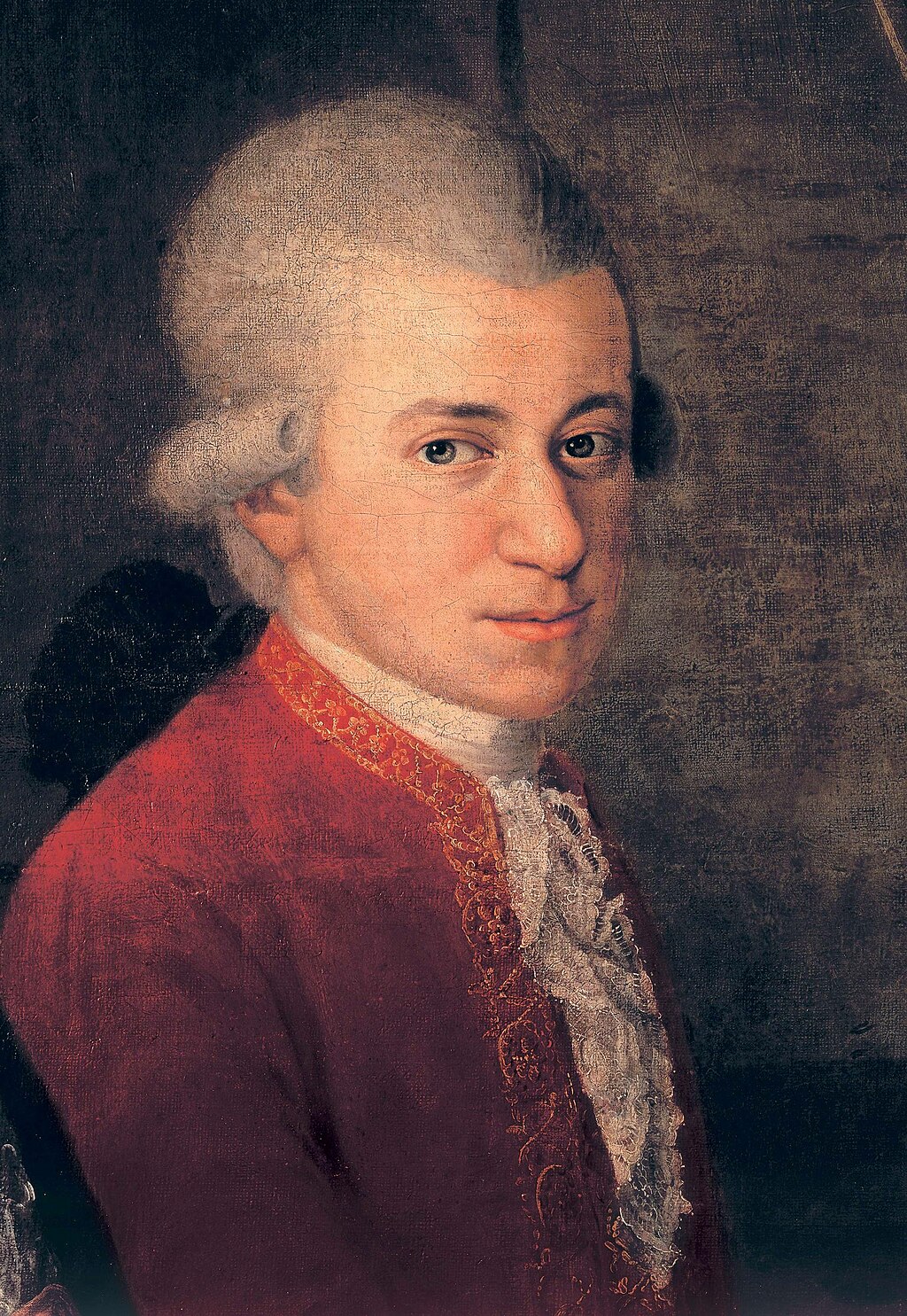
ウォルフガング・アマデウス・モーツァルト
Wolfgang Amadeus Mozart, 1756-1791
Detail
of Wolfgang Amadeus Mozart from Mozart family portrait by Croce
☆ ヴォルフガング・アマデウス・モーツァルト[Wolfgang Amadeus Mozart](1756年1月27日~1791年12月5日)は、古典派時代の多作で影響力のある作曲家であ る。短命であったが、作曲のペースは速く、800曲以上の作品を残した。これらの作品の多くは、交響曲、協奏曲、室内楽、オペラ、合唱のレパートリーの頂 点として認められている。モーツァルトは、西洋音楽史上最も偉大な作曲家の一人として広く認められており[1]、彼の音楽は「旋律の美しさ、形式的な優雅 さ、和声とテクスチュアの豊かさ」[2]で賞賛されている。 当時神聖ローマ帝国、現在はオーストリアの ザルツブルクに生まれたモーツァルトは、幼少期から天才的な才能を発揮した。5歳のときにはすでに鍵盤楽器とヴァイオリンの腕前があり、作曲を始め、ヨー ロッパの王族の前で演奏していた。父に連れられてヨーロッパを大旅行し、その後3度イタリアを訪れた。17歳でザルツブルクの宮廷楽師となったが、落ち着 きを失い、より良い地位を求めて旅に出た。パリ、マンハイム、ミュンヘン、そして再びザルツブルクで職を得たモーツァルトは、その間に5曲のヴァイオリン 協奏曲、シンフォニア・コンチェルタンテ、フルートとハープのための協奏曲のほか、聖歌やミサ曲、モテット「Exsultate Jubilate」、オペラ「Idomeneo」などを作曲した。 1781年にウィーンを訪れたモーツァルトは、ザルツブルクの職を解かれた。彼はウィーンに留まり、名声を得たが、経済的にはほとんど安定しなかった。 ウィーンで過ごしたモーツァルトは、オペラ『愛の門』、『大ミサ曲ハ短調』、『ハイドン四重奏曲』、交響曲の数々など、数々の名作を残した。モーツァルト はウィーン時代を通じて10曲以上のピアノ協奏曲を作曲し、その多くが彼の最高傑作とされている。最晩年には、ジュピター交響曲、セレナード「アイネ・ク ライネ・ナハトムジーク」、クラリネット協奏曲、4つのオペラ「フィガロの結婚」、「ドン・ジョヴァンニ」、「コジ・ファン・トゥッテ」、「魔笛」、レク イエムなど、モーツァルトの代表作の多くを作曲した。レクイエムは、35歳で亡くなった時点ではほとんど未完成であった。
| Wolfgang Amadeus
Mozart[a][b] (27 January 1756 – 5 December 1791) was a prolific and
influential composer of the Classical period. Despite his short life,
his rapid pace of composition resulted in more than 800 works
representing virtually every Western classical genre of his time. Many
of these compositions are acknowledged as pinnacles of the symphonic,
concertante, chamber, operatic, and choral repertoire. Mozart is widely
regarded as one of the greatest composers in the history of Western
music,[1] with his music admired for its "melodic beauty, its formal
elegance and its richness of harmony and texture".[2] Born in Salzburg, then in the Holy Roman Empire and now in Austria, Mozart showed prodigious ability from his earliest childhood. At age five he was already competent on keyboard and violin, he had begun to compose, and he performed before European royalty. His father took him on a grand tour of Europe and then three trips to Italy. At 17, he was a musician at the Salzburg court but grew restless and travelled in search of a better position. Mozart's search for employment led to positions in Paris, Mannheim, Munich, and again in Salzburg, during which he wrote his five violin concertos, Sinfonia Concertante, and Concerto for Flute and Harp, as well as sacred pieces and masses, the motet Exsultate Jubilate, and the opera Idomeneo, among other works. While visiting Vienna in 1781, Mozart was dismissed from his Salzburg position. He stayed in Vienna, where he achieved fame but little financial security. During Mozart’s early years in Vienna, he produced several notable works, such as the opera Die Entführung aus dem Serail, the Great Mass in C Minor, the "Haydn" Quartets and a number of symphonies. Throughout his Vienna years, Mozart composed over a dozen piano concertos, many considered some of his greatest achievements. In the final years of his life, Mozart wrote many of his best-known works, including his last three symphonies, culminating in the Jupiter Symphony, the serenade Eine kleine Nachtmusik, his Clarinet Concerto, the four operas Le nozze di Figaro, Don Giovanni, Così fan tutte and The Magic Flute and his Requiem. The Requiem was largely unfinished at the time of his death at age 35, the circumstances of which are uncertain and much mythologised. |
ヴォルフガング・アマデウス・モーツァルト[a][b](1756年1
月27日~1791年12月5日)は、古典派時代の多作で影響力のある作曲家である。短命であったが、作曲のペースは速く、800曲以上の作品を残した。
これらの作品の多くは、交響曲、協奏曲、室内楽、オペラ、合唱のレパートリーの頂点として認められている。モーツァルトは、西洋音楽史上最も偉大な作曲家
の一人として広く認められており[1]、彼の音楽は「旋律の美しさ、形式的な優雅さ、和声とテクスチュアの豊かさ」[2]で賞賛されている。 当時神聖ローマ帝国、現在はオーストリアの ザルツブルクに生まれたモーツァルトは、幼少期から天才的な才能を発揮した。5歳のときにはすでに鍵盤楽器とヴァイオリンの腕前があり、作曲を始め、ヨー ロッパの王族の前で演奏していた。父に連れられてヨーロッパを大旅行し、その後3度イタリアを訪れた。17歳でザルツブルクの宮廷楽師となったが、落ち着 きを失い、より良い地位を求めて旅に出た。パリ、マンハイム、ミュンヘン、そして再びザルツブルクで職を得たモーツァルトは、その間に5曲のヴァイオリン 協奏曲、シンフォニア・コンチェルタンテ、フルートとハープのための協奏曲のほか、聖歌やミサ曲、モテット「Exsultate Jubilate」、オペラ「Idomeneo」などを作曲した。 1781年にウィーンを訪れたモーツァルトは、ザルツブルクの職を解かれた。彼はウィーンに留まり、名声を得たが、経済的にはほとんど安定しなかった。 ウィーンで過ごしたモーツァルトは、オペラ『愛の門』、『大ミサ曲ハ短調』、『ハイドン四重奏曲』、交響曲の数々など、数々の名作を残した。モーツァルト はウィーン時代を通じて10曲以上のピアノ協奏曲を作曲し、その多くが彼の最高傑作とされている。最晩年には、ジュピター交響曲、セレナード「アイネ・ク ライネ・ナハトムジーク」、クラリネット協奏曲、4つのオペラ「フィガロの結婚」、「ドン・ジョヴァンニ」、「コジ・ファン・トゥッテ」、「魔笛」、レク イエムなど、モーツァルトの代表作の多くを作曲した。レクイエムは、35歳で亡くなった時点ではほとんど未完成であった。 |
Life and career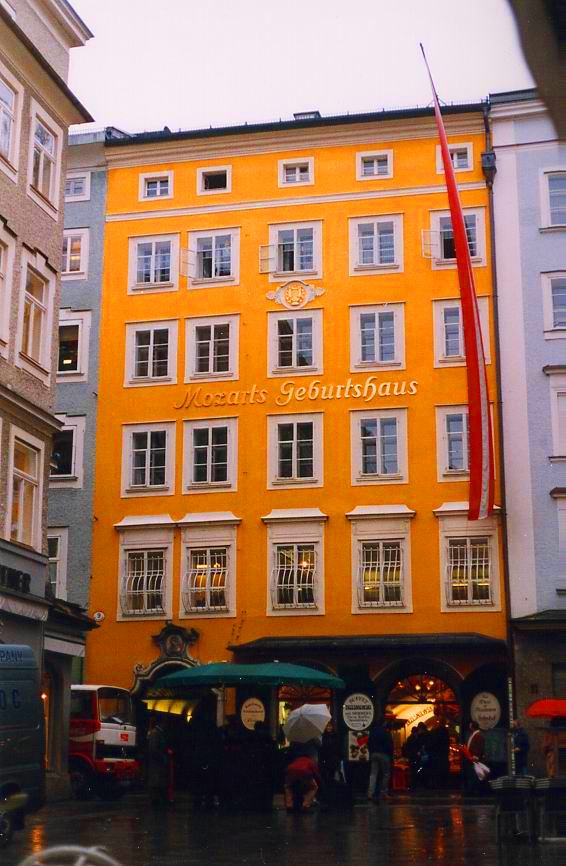 Mozart's birthplace at Getreidegasse 9, Salzburg Early life Family and childhood See also: Mozart's name, Mozart family, and Mozart's nationality Wolfgang Amadeus Mozart was born on 27 January 1756 to Leopold Mozart and Anna Maria, née Pertl, at Getreidegasse 9 in Salzburg.[3] Salzburg was the capital of the Archbishopric of Salzburg, an ecclesiastic principality in the Holy Roman Empire (today in Austria).[c] He was the youngest of seven children, five of whom died in infancy. His elder sister was Maria Anna Mozart (1751–1829), nicknamed "Nannerl". Mozart was baptised the day after his birth, at St. Rupert's Cathedral in Salzburg. The baptismal record gives his name in Latinized form, as Joannes Chrysostomus Wolfgangus Theophilus Mozart. He generally called himself "Wolfgang Amadè Mozart"[4] as an adult, but his name had many variants. Leopold Mozart, a native of Augsburg,[5] then an Imperial Free City in the Holy Roman Empire, was a minor composer and an experienced teacher. In 1743, he was appointed as the fourth violinist in the musical establishment of Count Leopold Anton von Firmian, the ruling Prince-Archbishop of Salzburg.[2] Four years later, he married Anna Maria in Salzburg. Leopold became the orchestra's deputy Kapellmeister in 1763. During the year of his son's birth, Leopold published a violin textbook, Versuch einer gründlichen Violinschule, which achieved success.[6] When Nannerl was seven, she began keyboard lessons with her father, while her three-year-old brother looked on. Years later, after her brother's death, she reminisced: He often spent much time at the clavier, picking out thirds, which he was ever striking, and his pleasure showed that it sounded good. ... In the fourth year of his age his father, for a game as it were, began to teach him a few minuets and pieces at the clavier. ... He could play it faultlessly and with the greatest delicacy, and keeping exactly in time. ... At the age of five, he was already composing little pieces, which he played to his father who wrote them down.[7] 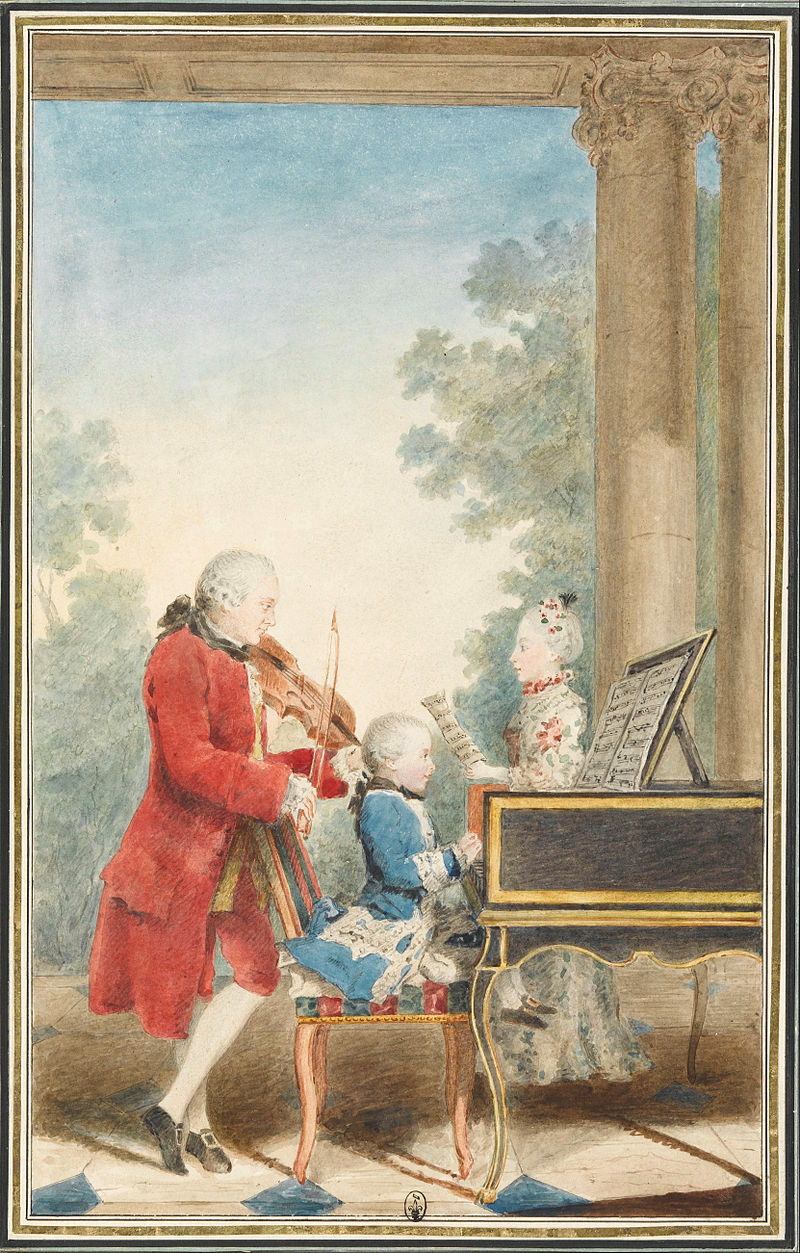 Mozart family on tour: Leopold, Wolfgang, Nannerl; watercolour by Carmontelle, c. 1763[8] These early pieces, K. 1–5, were recorded in the Nannerl Notenbuch. There is some scholarly debate about whether Mozart was four or five years old when he created his first musical compositions, though there is little doubt that Mozart composed his first three pieces of music within a few weeks of each other: K. 1a, 1b, and 1c.[9] In his early years, Wolfgang's father was his only teacher. Along with music, he taught his children languages and academic subjects.[10] Biographer Solomon notes that, while Leopold was a devoted teacher to his children, there is evidence that Mozart was keen to progress beyond what he was taught.[10] His first ink-spattered composition and his precocious efforts with the violin were of his initiative and came as a surprise to Leopold,[11] who eventually gave up composing when his son's musical talents became evident.[12] 1762–73: Travel Main articles: Mozart family grand tour and Mozart in Italy While Wolfgang was young, his family made several European journeys in which he and Nannerl performed as child prodigies. These began with an exhibition in 1762 at the court of Prince-elector Maximilian III of Bavaria in Munich, and at the Imperial Courts in Vienna and Prague. A long concert tour followed, spanning three and a half years, taking the family to the courts of Munich, Mannheim, Paris, London,[13] Dover, The Hague, Amsterdam, Utrecht, Mechelen and again to Paris, and back home via Zürich, Donaueschingen, and Munich.[14] During this trip, Wolfgang met many musicians and acquainted himself with the works of other composers. A particularly significant influence was Johann Christian Bach, whom he visited in London in 1764 and 1765. When he was eight years old, Mozart wrote his first symphony, most of which was probably transcribed by his father.[15]  Mozart aged 14 in January 1770 (School of Verona, attributed to Giambettino Cignaroli) Composed 9 October 1770 for admission to the Accademia Filarmonica di Bologna; Performed by Phillip W. Serna, treble, tenor & bass viols The family trips were often challenging, and travel conditions were primitive.[16] They had to wait for invitations and reimbursement from the nobility, and they endured long, near-fatal illnesses far from home: first Leopold (London, summer 1764),[17] then both children (The Hague, autumn 1765).[18] The family again went to Vienna in late 1767 and remained there until December 1768. After one year in Salzburg, Leopold and Wolfgang set off for Italy, leaving Anna Maria and Nannerl at home. This tour lasted from December 1769 to March 1771. As with earlier journeys, Leopold wanted to display his son's abilities as a performer and a rapidly maturing composer. Wolfgang met Josef Mysliveček and Giovanni Battista Martini in Bologna and was accepted as a member of the famous Accademia Filarmonica. There exists a myth, according to which, while in Rome, he heard Gregorio Allegri's Miserere twice in performance in the Sistine Chapel. Allegedly, he subsequently wrote it out from memory, thus producing the "first unauthorized copy of this closely guarded property of the Vatican". However, both origin and plausibility of this account are disputed.[19][20][d][21] In Milan, Mozart wrote the opera Mitridate, re di Ponto (1770), which was performed with success. This led to further opera commissions. He returned with his father twice to Milan (August–December 1771; October 1772 – March 1773) for the composition and premieres of Ascanio in Alba (1771) and Lucio Silla (1772). Leopold hoped these visits would result in a professional appointment for his son, and indeed ruling Archduke Ferdinand contemplated hiring Mozart, but owing to his mother Empress Maria Theresa's reluctance to employ "useless people", the matter was dropped[e] and Leopold's hopes were never realized.[22] Toward the end of the journey, Mozart wrote the solo motet Exsultate, jubilate, K.165. 1773–77: Employment at the Salzburg court 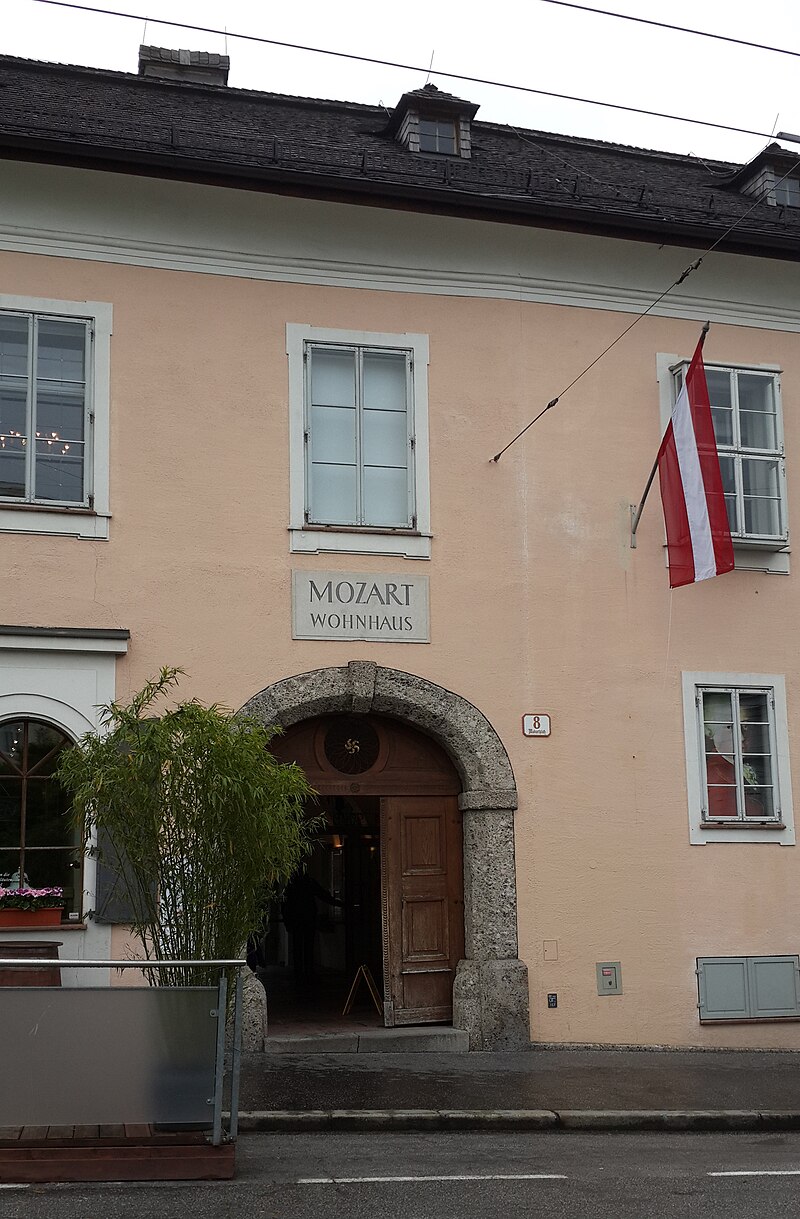 Tanzmeisterhaus [de], Salzburg, Mozart family residence from 1773; reconstructed 1996 After finally returning with his father from Italy on 13 March 1773, Mozart was employed as a court musician by the ruler of Salzburg, Prince-Archbishop Hieronymus Colloredo. The composer had many friends and admirers in Salzburg[23] and had the opportunity to work in many genres, including symphonies, sonatas, string quartets, masses, serenades, and a few minor operas. Between April and December 1775, Mozart developed an enthusiasm for violin concertos, producing a series of five (the only ones he ever wrote), which steadily increased in their musical sophistication. The last three—K. 216, K. 218, K. 219—are now staples of the repertoire. In 1776, he turned his efforts to piano concertos, culminating in the E♭ concerto K. 271 of early 1777, considered by critics to be a breakthrough work.[24] Despite these artistic successes, Mozart grew increasingly discontented with Salzburg and redoubled his efforts to find a position elsewhere. One reason was his low salary, 150 florins a year;[25] Mozart longed to compose operas, and Salzburg provided only rare occasions for these. The situation worsened in 1775 when the court theatre was closed, especially since the other theatre in Salzburg was primarily reserved for visiting troupes.[26] Two long expeditions in search of work interrupted this long Salzburg stay. Mozart and his father visited Vienna from 14 July to 26 September 1773, and Munich from 6 December 1774 to March 1775. Neither visit was successful, though the Munich journey resulted in a popular success with the premiere of Mozart's opera La finta giardiniera.[27] 1777–78: Journey to Paris 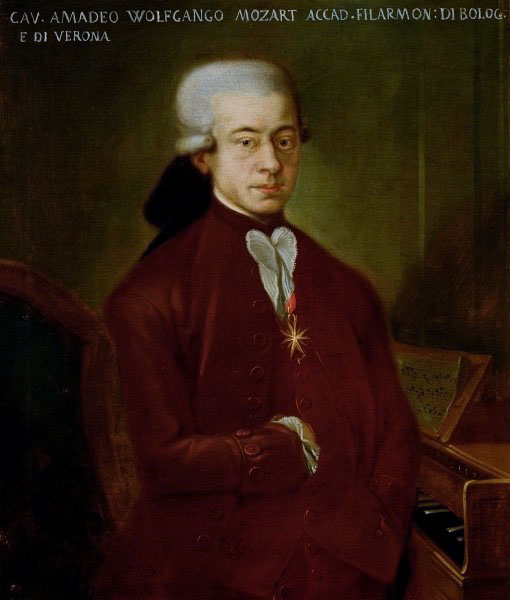 Mozart wearing the badge of the Order of the Golden Spur which he received in 1770 from Pope Clement XIV in Rome. The painting is a 1777 copy of a work now lost.[28] In August 1777, Mozart resigned his position at Salzburg[29][f] and on 23 September ventured out once more in search of employment, with visits to Augsburg, Mannheim, Paris, and Munich.[30] Mozart became acquainted with members of the famous orchestra in Mannheim, the best in Europe at the time. He also fell in love with Aloysia Weber, one of four daughters of a musical family. There were prospects of employment in Mannheim, but they came to nothing,[31] and Mozart left for Paris on 14 March 1778[32] to continue his search. One of his letters from Paris hints at a possible post as an organist at Versailles, but Mozart was not interested in such an appointment.[33] He fell into debt and took to pawning valuables.[34] The nadir of the visit occurred when Mozart's mother was taken ill and died on 3 July 1778.[35] There had been delays in calling a doctor—probably, according to Halliwell, because of a lack of funds.[36] Mozart stayed with Melchior Grimm at Marquise d'Épinay's residence, 5 rue de la Chaussée-d'Antin.[37] While Mozart was in Paris, his father was pursuing opportunities of employment for him in Salzburg.[38] With the support of the local nobility, Mozart was offered a post as court organist and concertmaster. The annual salary was 450 florins,[39] but he was reluctant to accept.[40] By that time, relations between Grimm and Mozart had cooled, and Mozart moved out. After leaving Paris in September 1778 for Strasbourg, he lingered in Mannheim and Munich, still hoping to obtain an appointment outside Salzburg. In Munich, he again encountered Aloysia, now a very successful singer, but she was no longer interested in him.[41] Mozart finally returned to Salzburg on 15 January 1779 and took up his new appointment, but his discontent with Salzburg remained undiminished.[42] Among the better-known works which Mozart wrote on the Paris journey are the A minor piano sonata, K. 310/300d, the "Paris" Symphony (No. 31), which were performed in Paris on 12 and 18 June 1778;[43] and the Concerto for Flute and Harp in C major, K. 299/297c.[44] Vienna 1781: Departure 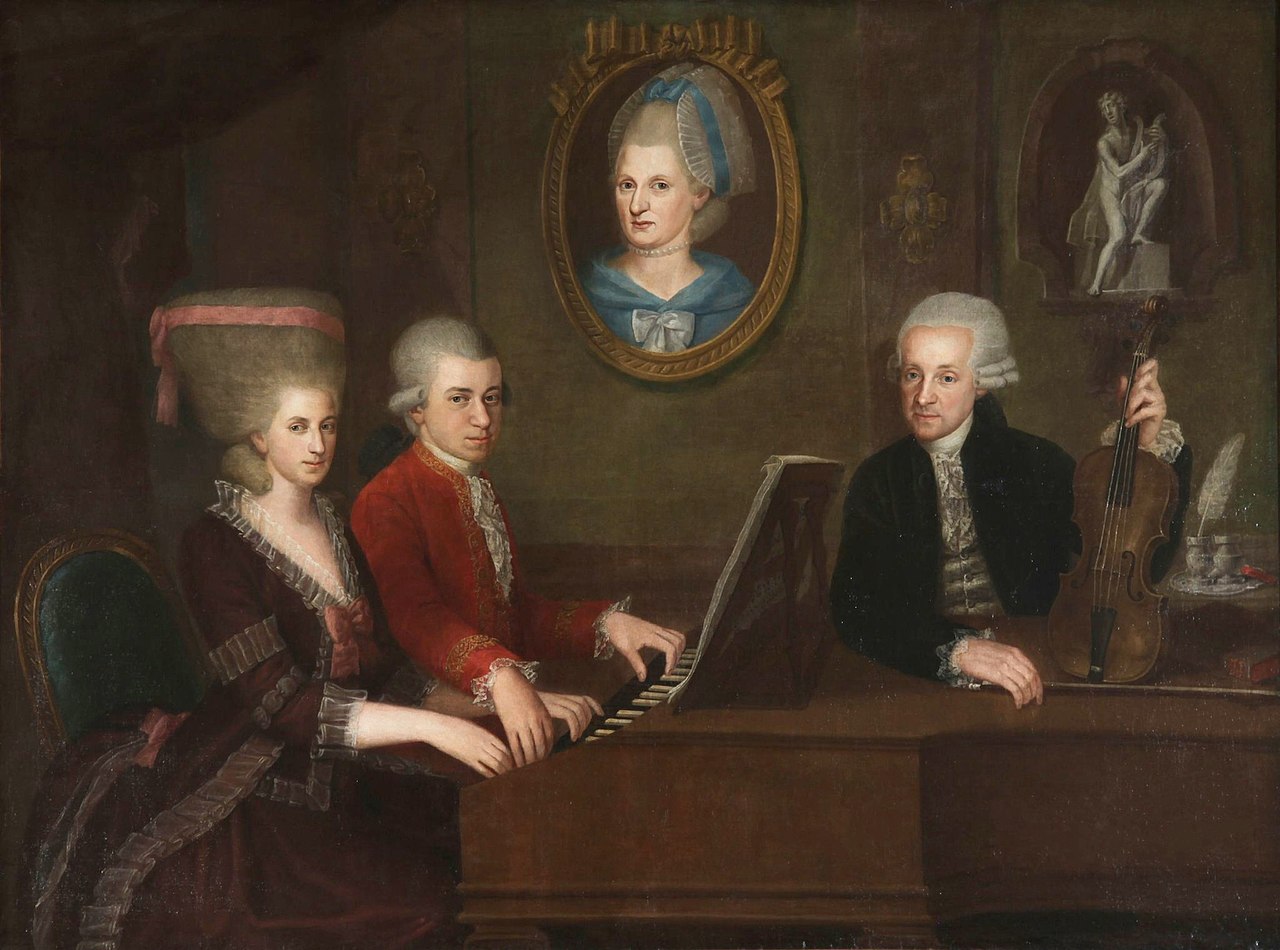 Mozart family, c. 1780 (della Croce); the portrait on the wall is of Mozart's mother. In January 1781, Mozart's opera Idomeneo premiered with "considerable success" in Munich.[45] The following March, Mozart was summoned to Vienna, where his employer, Archbishop Colloredo, was attending the celebrations for the accession of Joseph II to the Austrian throne. For Colloredo, this was simply a matter of wanting his musical servant to be at hand (Mozart indeed was required to dine in Colloredo's establishment with the valets and cooks).[g] He planned a bigger career as he continued in the archbishop's service;[47] for example, he wrote to his father: My main goal right now is to meet the emperor in some agreeable fashion, I am absolutely determined he should get to know me. I would be so happy if I could whip through my opera for him and then play a fugue or two, for that's what he likes.[48] Mozart did indeed soon meet the Emperor, who eventually was to support his career substantially with commissions and a part-time position. In the same letter to his father just quoted, Mozart outlined his plans to participate as a soloist in the concerts of the Tonkünstler-Societät, a prominent benefit concert series;[48] this plan as well came to pass after the local nobility prevailed on Colloredo to drop his opposition.[49] Colloredo's wish to prevent Mozart from performing outside his establishment was in other cases carried through, raising the composer's anger; one example was a chance to perform before the Emperor at Countess Thun's for a fee equal to half of his yearly Salzburg salary. The quarrel with the archbishop came to a head in May: Mozart attempted to resign and was refused. The following month, permission was granted, but in a grossly insulting way: the composer was dismissed literally "with a kick in the arse", administered by the archbishop's steward, Count Arco. Mozart decided to settle in Vienna as a freelance performer and composer.[50] The quarrel with Colloredo was more difficult for Mozart because his father sided against him. Hoping fervently that he would obediently follow Colloredo back to Salzburg, Mozart's father exchanged intense letters with his son, urging him to be reconciled with their employer. Mozart passionately defended his intention to pursue an independent career in Vienna. The debate ended when Mozart was dismissed by the archbishop, freeing himself both of his employer and of his father's demands to return. Solomon characterizes Mozart's resignation as a "revolutionary step" that significantly altered the course of his life.[51] Early years See also: Haydn and Mozart and Mozart and Freemasonry Mozart's new career in Vienna began well. He often performed as a pianist, notably in a competition before the Emperor with Muzio Clementi on 24 December 1781,[50] and he soon "had established himself as the finest keyboard player in Vienna".[50] He also prospered as a composer, and in 1782 completed the opera Die Entführung aus dem Serail ("The Abduction from the Seraglio"), which premiered on 16 July 1782 and achieved considerable success. The work was soon being performed "throughout German-speaking Europe",[50] and thoroughly established Mozart's reputation as a composer. 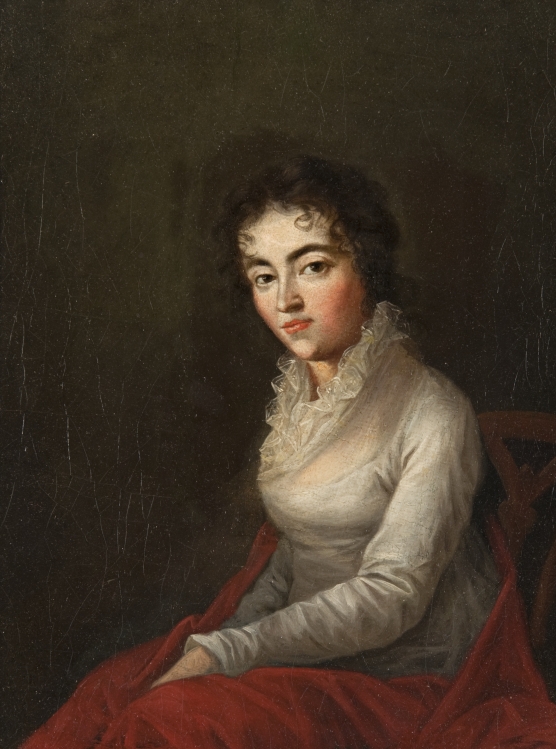 1782 portrait of Constanze Mozart by her brother-in-law Joseph Lange Near the height of his quarrels with Colloredo, Mozart moved in with the Weber family, who had moved to Vienna from Mannheim. The family's father, Fridolin, had died, and the Webers were now taking in lodgers to make ends meet.[52] Marriage and children After failing to win the hand of Aloysia Weber, who was now married to the actor and artist Joseph Lange, Mozart's interest shifted to the third daughter of the family, Constanze. The courtship did not go entirely smoothly; surviving correspondence indicates that Mozart and Constanze briefly broke up in April 1782, over an episode involving jealousy (Constanze had permitted another young man to measure her calves in a parlor game).[53] Mozart also faced a very difficult task getting permission for the marriage from his father, Leopold.[54] The marriage took place in an atmosphere of crisis. Daniel Heartz suggests that eventually Constanze moved in with Mozart, which would have placed her in disgrace by the mores of the time.[55] Mozart wrote to Leopold on 31 July 1782, "All the good and well-intentioned advice you have sent fails to address the case of a man who has already gone so far with a maiden. Further postponement is out of the question."[55] Heartz relates, "Constanze's sister Sophie had tearfully declared that her mother would send the police after Constanze if she did not return home [presumably from Mozart's apartment]."[55] On 4 August, Mozart wrote to Baroness von Waldstätten, asking: "Can the police here enter anyone's house in this way? Perhaps it is only a ruse of Madame Weber to get her daughter back. If not, I know no better remedy than to marry Constanze tomorrow morning or if possible today."[55] The couple were finally married on 4 August 1782 in St. Stephen's Cathedral, the day before his father's consenting letter arrived in the mail. In the marriage contract, Constanze "assigns to her bridegroom five hundred gulden which ... the latter has promised to augment with one thousand gulden", with the total "to pass to the survivor". Further, all joint acquisitions during the marriage were to remain the common property of both.[56] The couple had six children, of whom only two survived infancy:[57] Raimund Leopold (17 June – 19 August 1783) Karl Thomas Mozart (21 September 1784 – 31 October 1858) Johann Thomas Leopold (18 October – 15 November 1786) Theresia Constanzia Adelheid Friedericke Maria Anna (27 December 1787 – 29 June 1788) Anna Maria (died soon after birth, 16 November 1789) Franz Xaver Wolfgang Mozart (26 July 1791 – 29 July 1844) 1782–87 In 1782 and 1783, Mozart became intimately acquainted with the work of Johann Sebastian Bach and George Frideric Handel as a result of the influence of Gottfried van Swieten, who owned many manuscripts of the Baroque masters. Mozart's study of these scores inspired compositions in Baroque style and later influenced his musical language, for example in fugal passages in Die Zauberflöte ("The Magic Flute") and the finale of Symphony No. 41.[2] In 1783, Mozart and his wife visited his family in Salzburg. His father and sister were cordially polite to Constanze, but the visit prompted the composition of one of Mozart's great liturgical pieces, the Mass in C minor. Though not completed, it was premiered in Salzburg, with Constanze singing a solo part.[58] Mozart met Joseph Haydn in Vienna around 1784, and the two composers became friends. When Haydn visited Vienna, they sometimes played together in an impromptu string quartet. Mozart's six quartets dedicated to Haydn (K. 387, K. 421, K. 428, K. 458, K. 464, and K. 465) date from the period 1782 to 1785, and are judged to be a response to Haydn's Opus 33 set from 1781.[59] Haydn wrote, "posterity will not see such a talent again in 100 years"[60] and in 1785 told Mozart's father: "I tell you before God, and as an honest man, your son is the greatest composer known to me by person and repute, he has taste and what is more the greatest skill in composition."[61] From 1782 to 1785 Mozart mounted concerts with himself as a soloist, presenting three or four new piano concertos in each season. Since space in the theatres was scarce, he booked unconventional venues: a large room in the Trattnerhof apartment building, and the ballroom of the Mehlgrube restaurant.[62] The concerts were very popular, and his concertos premiered there are still firm fixtures in his repertoire. Solomon writes that during this period, Mozart created "a harmonious connection between an eager composer-performer and a delighted audience, which was given the opportunity of witnessing the transformation and perfection of a major musical genre".[62] With substantial returns from his concerts and elsewhere, Mozart and his wife adopted a more luxurious lifestyle. They moved to an expensive apartment, with a yearly rent of 460 florins.[63] Mozart bought a fine fortepiano from Anton Walter for about 900 florins, and a billiard table for about 300.[63] The Mozarts sent their son Karl Thomas to an expensive boarding school[64][65] and kept servants. During this period Mozart saved little of his income.[66][67] On 14 December 1784, Mozart became a Freemason, admitted to the lodge Zur Wohltätigkeit ("Beneficence").[68] Freemasonry played an essential role in the remainder of Mozart's life: he attended meetings, a number of his friends were Masons, and on various occasions, he composed Masonic music, e.g. the Maurerische Trauermusik.[69] 1786–87: Return to opera 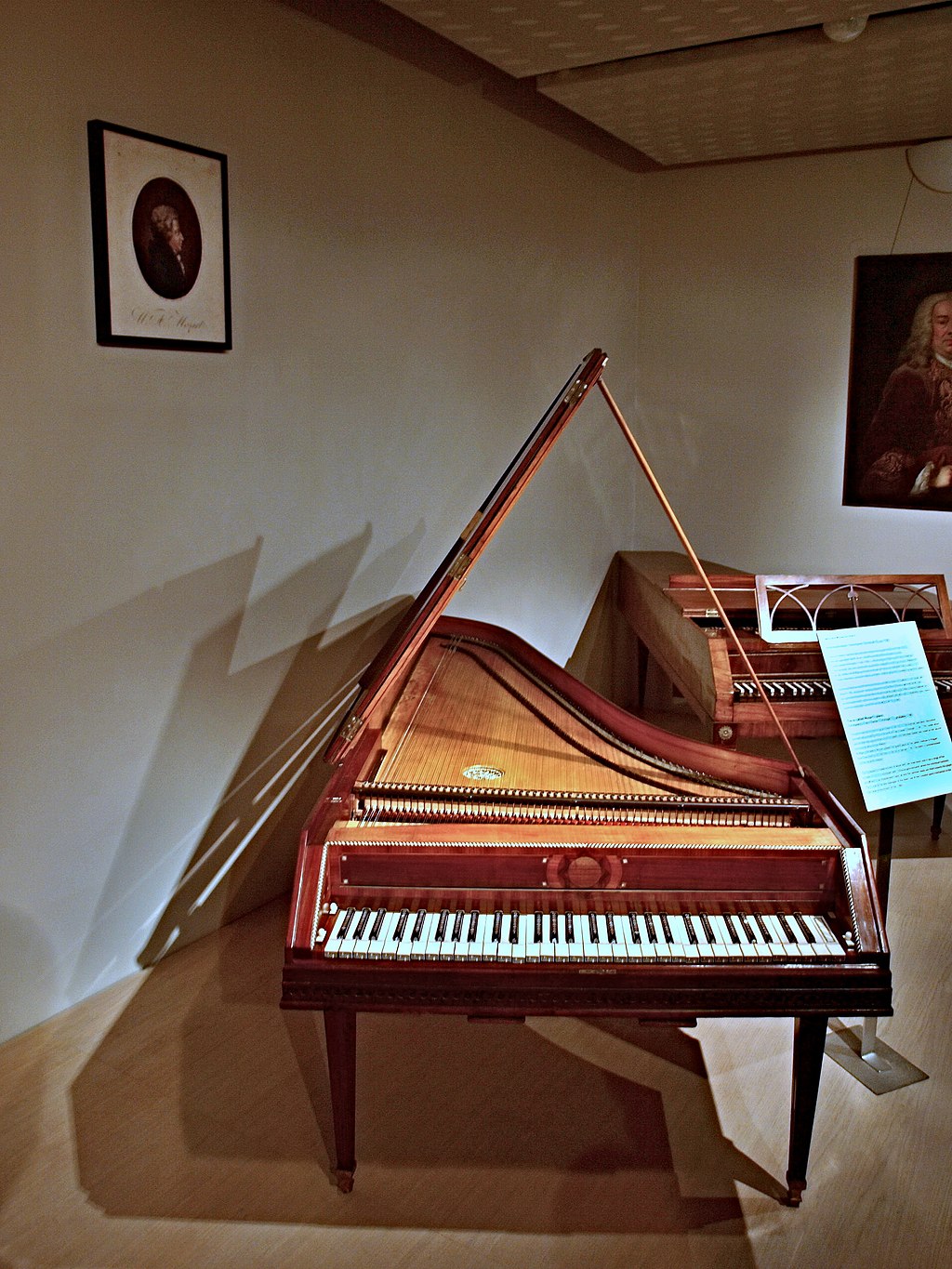 Fortepiano played by Mozart in 1787, Czech Museum of Music, Prague[70] Despite the great success of Die Entführung aus dem Serail, Mozart did little operatic writing for the next four years, producing only two unfinished works and the one-act Der Schauspieldirektor. He focused instead on his career as a piano soloist and writer of concertos. Around the end of 1785, Mozart moved away from keyboard writing[71][page needed] and began his famous operatic collaboration with the librettist Lorenzo Da Ponte. The year 1786 saw the successful premiere of Le nozze di Figaro in Vienna. Its reception in Prague later in the year was even warmer, and this led to a second collaboration with Da Ponte: the opera Don Giovanni, which premiered in October 1787 to acclaim in Prague, but less success in Vienna during 1788.[72] The two are among Mozart's most famous works and are mainstays of operatic repertoire today, though at their premieres their musical complexity caused difficulty both for listeners and for performers. These developments were not witnessed by Mozart's father, who had died on 28 May 1787.[73] In December 1787, Mozart finally obtained a steady post under aristocratic patronage. Emperor Joseph II appointed him as his "chamber composer", a post that had fallen vacant the previous month on the death of Gluck. It was a part-time appointment, paying just 800 florins per year, and required Mozart only to compose dances for the annual balls in the Redoutensaal (see Mozart and dance). This modest income became important to Mozart when hard times arrived. Court records show that Joseph aimed to keep the esteemed composer from leaving Vienna in pursuit of better prospects.[74][1] In 1787, the young Ludwig van Beethoven spent several weeks in Vienna, hoping to study with Mozart.[75] No reliable records survive to indicate whether the two composers ever met. Later years 1788–90 See also: Mozart's Berlin journey 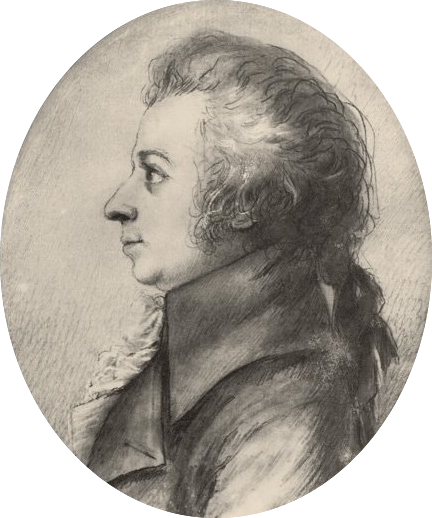 Drawing of Mozart in silverpoint, made by Dora Stock during Mozart's visit to Dresden, April 1789 Toward the end of the decade, Mozart's circumstances worsened. Around 1786 he had ceased to appear frequently in public concerts, and his income shrank.[76] This was a difficult time for musicians in Vienna because of the Austro-Turkish War: both the general level of prosperity and the ability of the aristocracy to support music had declined. In 1788, Mozart saw a 66% decline in his income compared to his best years in 1781.[77] By mid-1788, Mozart and his family had moved from central Vienna to the suburb of Alsergrund.[76] Although it has been suggested that Mozart aimed to reduce his rental expenses by moving to a suburb, as he wrote in his letter to Michael von Puchberg, Mozart had not reduced his expenses but merely increased the housing space at his disposal.[78] Mozart began to borrow money, most often from his friend and fellow mason Puchberg; "a pitiful sequence of letters pleading for loans" survives.[79] Maynard Solomon and others have suggested that Mozart was suffering from depression, and it seems his musical output slowed.[80] Major works of the period include the last three symphonies (Nos. 39, 40, and 41, all from 1788), and the last of the three Da Ponte operas, Così fan tutte, premiered in 1790. Around this time, Mozart made some long journeys hoping to improve his fortunes, visiting Leipzig, Dresden, and Berlin in the spring of 1789, and Frankfurt, Mannheim, and other German cities in 1790. 1791 Mozart's last year was, until his final illness struck, a time of high productivity—and by some accounts, one of personal recovery.[81][h] He composed a great deal, including some of his most admired works: the opera The Magic Flute; the final piano concerto (K. 595 in B♭); the Clarinet Concerto K. 622; the last in his series of string quintets (K. 614 in E♭); the motet Ave verum corpus K. 618; and the unfinished Requiem K. 626. Mozart's financial situation, a source of anxiety in 1790, finally began to improve. Although the evidence is inconclusive,[82] it appears that wealthy patrons in Hungary and Amsterdam pledged annuities to Mozart in return for the occasional composition. He is thought to have benefited from the sale of dance music written in his role as Imperial chamber composer.[82] Mozart no longer borrowed large sums from Puchberg and began to pay off his debts.[82] He experienced great satisfaction in the public success of some of his works, notably The Magic Flute (which was performed several times in the short period between its premiere and Mozart's death)[83] and the Little Masonic Cantata K. 623, premiered on 17 November 1791.[84] Final illness and death Main article: Death of Wolfgang Amadeus Mozart 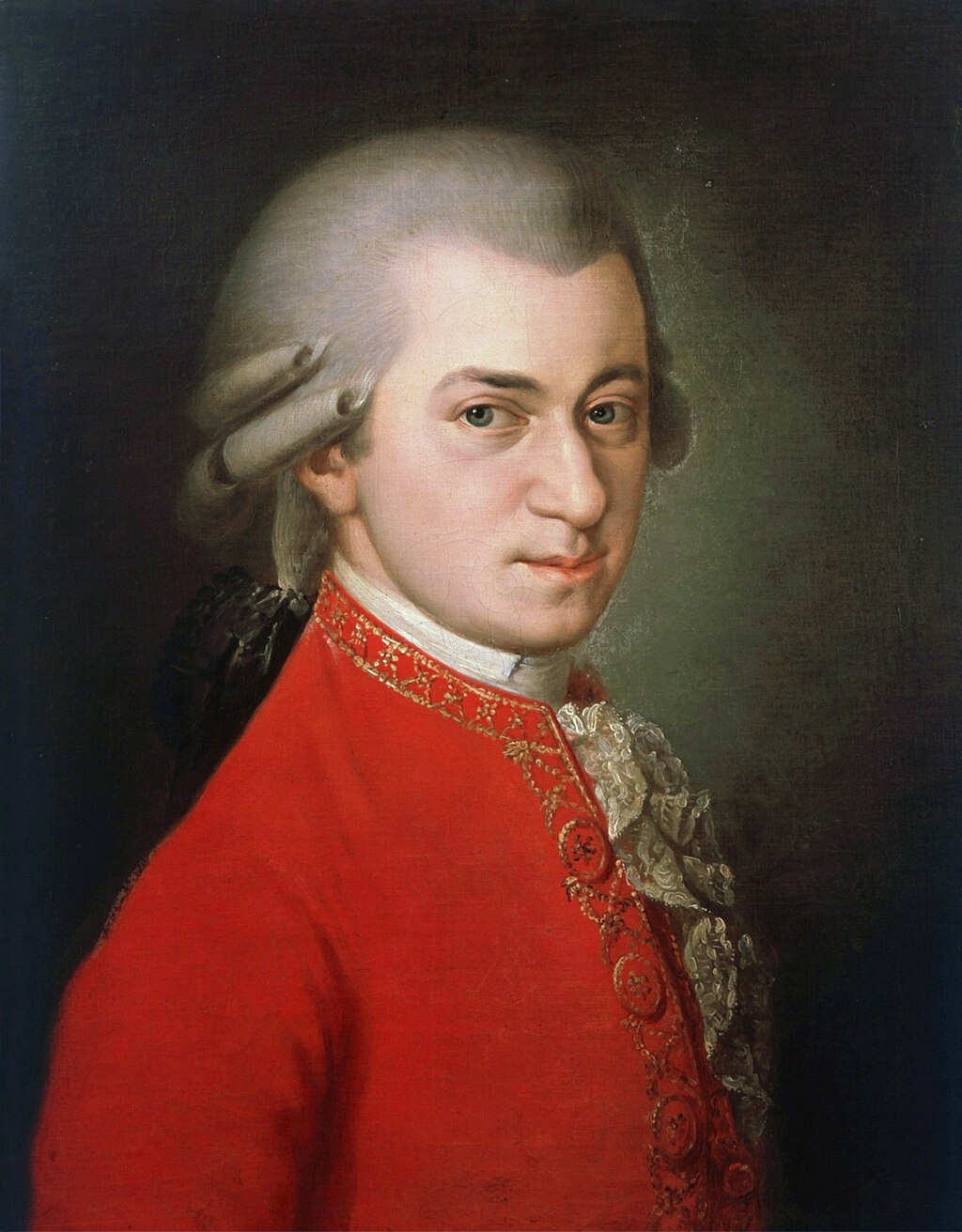 Posthumous painting by Barbara Krafft in 1819 Mozart fell ill while in Prague for the premiere, on 6 September 1791, of his opera La clemenza di Tito, which was written in that same year on commission for Emperor Leopold II's coronation festivities.[85] He continued his professional functions for some time and conducted the premiere of The Magic Flute on 30 September. His health deteriorated on 20 November, at which point he became bedridden, suffering from swelling, pain, and vomiting.[86] Mozart was nursed in his final days by his wife and her youngest sister, and was attended by the family doctor, Thomas Franz Closset. He was mentally occupied with the task of finishing his Requiem, but the evidence that he dictated passages to his student Franz Xaver Süssmayr is minimal.[87] Mozart died in his home on 5 December 1791 (aged 35) at 12:55 am.[88] The New Grove describes his funeral: Mozart was interred in a common grave, in accordance with contemporary Viennese custom, at the St. Marx Cemetery outside the city on 7 December. If, as later reports say, no mourners attended, that too is consistent with Viennese burial customs at the time; later Otto Jahn (1856) wrote that Salieri, Süssmayr, van Swieten and two other musicians were present. The tale of a storm and snow is false; the day was calm and mild.[89] The expression "common grave" refers to neither a communal grave nor a pauper's grave, but an individual grave for a member of the common people (i.e., not the aristocracy). Common graves were subject to excavation after ten years; the graves of aristocrats were not.[90] The cause of Mozart's death is not known with certainty. The official record of hitziges Frieselfieber ("severe miliary fever", referring to a rash that looks like millet seeds) is more a symptomatic description than a diagnosis. Researchers have suggested more than a hundred causes of death, including acute rheumatic fever,[91][92] streptococcal infection,[93][94] trichinosis,[95][96] influenza, mercury poisoning, and a rare kidney ailment.[91] Mozart's modest funeral did not reflect his standing with the public as a composer; memorial services and concerts in Vienna and Prague were well attended. Indeed, in the period immediately after his death, his reputation rose substantially. Solomon describes an "unprecedented wave of enthusiasm"[97] for his work; biographies were written first by Schlichtegroll, Niemetschek, and Nissen, and publishers vied to produce complete editions of his works.[97] |
生涯とキャリア ザルツブルクのゲトライデガッセ9番地にあるモーツァルトの生家 生い立ち 家族と子供時代 以下も参照のこと: モーツァルトの名前、モーツァルトの家族、モーツァルトの国籍 ヴォルフガング・アマデウス・モーツァルトは、1756年1月27日、レオポルト・モーツァルトと アンナ・マリア(旧姓ペルトル)の間に、ザルツブルクのゲトライデガッセ9番地に生まれた[3]。 ザルツブルクは神聖ローマ帝国(現在のオーストリア)の教会公国であったザルツブルク大司教座の首都であった[c]。姉はマリア・アンナ・モーツァルト (1751-1829)で、「ナンネル」の愛称で呼ばれた。モーツァルトは生まれた翌日、ザルツブルクの聖ルパート大聖堂で洗礼を受けた。洗礼式の記録に は、彼の名前がラテン語化された形で、ヨアンネス・クリュソストムス・ヴォルフガングス・テオフィルス・モーツァルトと記されている。成人してからは一般 的に「ヴォルフガング・アマデ・モーツァルト」[4]と名乗ったが、彼の名前には多くのバリエーションがあった。 レオポルト・モーツァルトは、当時神聖ローマ帝国の帝国自由都市であったアウクスブルク[5]出身で、マイナーな作曲家であり、経験豊かな教師でもあっ た。1743年、彼はザルツブルクの大司教公 レオポルト・アントン・フォン・フィルミアン伯爵の音楽院の第4ヴァイオリニストに任命された[2]。レオポルトは、1763年にオーケストラの副カペル マイスターとなった。息子が生まれた年、レオポルトはヴァイオリンの教科書『Versuch einer gründlichen Violinschule』を出版し、成功を収めた[6]。 ナンネルが7歳のとき、3歳の兄が見守る中、父のもとで鍵盤楽器のレッスンを始めた。数年後、兄の死後、彼女は回想した: 兄はよくクラヴィーアの前に座って、いつも三度の音を弾いていた。4歳になると、父親は遊びのつもりで、クラヴィーアのメヌエットや小品を教え始めた。彼 はメヌエットと小品を、完璧に、繊細に、正確に演奏することができた。... 5歳の時には、すでに小品を作曲し、それを書き留めた父親に聞かせていた[7]。  ツアー中のモーツァルト一家: レオポルト、ヴォルフガング、ナンネル、カルモンテルによる水彩画、1763年頃[8]。 これらの初期の作品K.1-5は、『ナンネル・ノート』に収録されている。モーツァルトが初めて作曲したのが4歳か5歳かについては、学者間でも議論があるが、モーツァルトが最初の3曲を数週間以内に作曲したことは間違いない: K.1a、1b、1cである[9]。 幼少期、ヴォルフガングの父親は唯一の教師であった。伝記作家のソロモンは、レオポルドが子供たちに熱心な教師であった一方で、モーツァルトが教えられた こと以上に進歩することに熱心であったことを示す証拠があると述べている[10]。 彼の最初のインクを散りばめた作曲と、早熟なヴァイオリンへの取り組みは、彼の自発的なものであり、レオポルドにとっては驚きであった[11]。 1762-73年:旅行 主な記事 モーツァルト家の大旅行と イタリアのモーツァルト ヴォルフガングが幼い頃、一家は何度かヨーロッパを旅し、ヴォルフガングとナンネルは神童として演奏を披露した。1762年、ミュンヘンのバイエルン選帝 侯 マクシミリアン3世の宮廷での展覧会に始まり、ウィーンとプラハの帝国宮廷でも展覧会が開かれた。その後、一家はミュンヘン、マンハイム、パリ、ロンド ン、ドーバー[13]、ハーグ、アムステルダム、ユトレヒト、メヘレン、そして再びパリを訪れ、チューリッヒ、ドナウエッシンゲン、ミュンヘンを経由して 帰国するという、3年半に及ぶ長い演奏旅行が続いた[14]。特に大きな影響を受けたのは、1764年と1765年にロンドンで訪れたヨハン・クリスティ アン・バッハであった。8歳の時、モーツァルトは最初の交響曲を書いたが、そのほとんどはおそらく父親が書き写したものであった[15]。  1770年1月、14歳のモーツァルト(ヴェローナの学校、ジャンベッティーノ・チニャローリの作とされる) 一家の旅はしばしば困難なもので、旅先の環境は原始的であった[16]。 貴族からの招待や払い戻しを待たなければならず、最初はレオポルド(1764年夏、ロンドン)[17]、次いで二人の子供たち(1765年秋、ハーグ) [18]が、故郷から遠く離れた地で長く瀕死の病に耐えた。 ザルツブルクでの1年の後、レオポルトとヴォルフガングはアンナ・マリアとナンネルを家に残し、イタリアへ旅立った。この旅は1769年12月から 1771年3月まで続いた。以前の旅と同様、レオポルトは息子の演奏家としての才能と、急速に成長する作曲家としての才能を見せつけようとした。ヴォルフ ガングはボローニャで ヨゼフ・マイスリヴェチェクと ジョヴァンニ・バッティスタ・マルティーニに出会い、有名なアカデミア・フィラルモニカのメンバーとして認められた。ローマ滞在中、グレゴリオ・アレグリ の「ミゼレーレ」をシスティーナ礼拝堂で2度聴いたという伝説がある。その後、彼はこの曲を記憶から書き起こし、「バチカンが厳重に管理しているこの曲の 最初の無許可コピー」を作ったと言われている。しかし、この説の出所と信憑性には異論がある[19][20][d][21]。 ミラノでモーツァルトはオペラ『ミトリダーテ、レ・ディ・ポント』(1770年)を作曲し、上演されて成功を収めた。これをきっかけに、さらなるオペラの 依頼が舞い込んだ。1771年8月~12月、1772年10月~1773年3月、父と共にミラノに戻り、『アルバのアスカニオ』(1771年)と『ルー チョ・シッラ』(1772年)の作曲と初演を行った。レオポルトは、これらの訪問が息子のプロとしての登用につながることを期待し、実際、フェルディナン ト大公はモーツァルトを雇うことを考えたが、母后マリア・テレジアが「役立たず」を雇うことを嫌ったため、この件は立ち消えとなり[e]、レオポルトの望 みは実現することはなかった[22]。 1773-77: ザルツブルクの宮廷に就職する。  タンツマイスターハウス[デ]、ザルツブルク、1773年からのモーツァルト一家の住居、1996年に再建された。 1773年3月13日、父親とともにイタリアからようやく帰国したモーツァルトは、ザルツブルクの統治者であるヒエロニムス・コロレド大司教に宮廷音楽家 として雇われた。作曲家はザルツブルクで多くの友人や崇拝者を持ち[23]、交響曲、ソナタ、弦楽四重奏曲、ミサ曲、セレナーデ、いくつかの小オペラな ど、多くのジャンルの作品を手がける機会を得た。1775年4月から12月にかけて、モーツァルトはヴァイオリン協奏曲に熱中し、5曲の連作(モーツァル トが作曲した唯一の協奏曲)を手がけた。最後の3曲-K. 216、K.218、K.219は、現在ではレパートリーの定番となっている。1776年、彼はピアノ協奏曲に力を入れ、1777年初頭の変ホ長調の協奏 曲K.271で頂点に達した。 このような芸術的成功にもかかわらず、モーツァルトはザルツブルグへの不満を募らせ、他で職を得ようと努力を重ねた。その理由のひとつは、年俸が150フ ロリンと低かったことである[25]。モーツァルトはオペラの作曲を切望していたが、ザルツブルクではそのような機会はめったになかった。1775年、宮 廷劇場が閉鎖されると状況は悪化し、特にザルツブルクのもうひとつの劇場は、主に客演劇団のためのものだった[26]。 この長いザルツブルク滞在の間に、仕事を求めて2度の長期遠征があった。モーツァルトとその父は、1773年7月14日から9月26日までウィーンを、 1774年12月6日から1775年3月までミュンヘンを訪れた。どちらの訪問も成功しなかったが、ミュンヘンの旅では、モーツァルトのオペラ『ラ・フィ ンタ・ジャルディニエラ』が初演され、人気を博した[27]。 1777-78年:パリへの旅  1770年にローマでローマ教皇クレメンス14世から授与された黄金拍車勲章のバッジをつけたモーツァルト。この絵は、1777年に描かれた作品の複製で、現在は失われている[28]。 1777年8月、モーツァルトはザルツブルクの職を辞し[29][f]、9月23日に再び職を求めてアウクスブルク、マンハイム、パリ、ミュンヘンを訪れた[30]。 モーツァルトはマンハイムで、当時ヨーロッパ最高の名門オーケストラのメンバーと知り合いになった。また、音楽一家に生まれた4人の娘の一人、アロイシ ア・ウェーバーと恋に落ちた。マンハイムでの就職の可能性もあったが、それは叶わず[31]、1778年3月14日、モーツァルトは探索を続けるためにパ リへと旅立った[32]。パリからの手紙の中には、ヴェルサイユ宮殿のオルガニストとしてのポストの可能性を示唆するものもあったが、モーツァルトはその ようなポストには興味を示さなかった[33]。 彼は借金を抱え、貴重品を質に入れるようになった[34]。 [35]医者を呼ぶのが遅れたが、ハリウェルによれば、おそらく資金不足のためであった[36]。モーツァルトはメルキオール・グリムのもとで、ショセ・ ダンティン通り5番地にあるエピネー侯爵夫人の邸宅に滞在した[37]。 モーツァルトがパリにいる間、父親はザルツブルグでモーツァルトの就職先を探していた。年俸は450フロリンであったが[39]、モーツァルトは難色を示 した[40]。その頃にはグリムとモーツァルトの関係は冷え切っており、モーツァルトはパリを離れる。1778年9月にパリを離れストラスブールに向かっ たモーツァルトは、マンハイムとミュンヘンに滞在し、ザルツブルク郊外での任命を希望していた。1779年1月15日、モーツァルトはようやくザルツブル クに戻り、新たな任に就いたが、ザルツブルクへの不満は消えなかった[42]。 モーツァルトがパリの旅で書いた作品としては、1778年6月12日と18日にパリで演奏されたイ短調のピアノ・ソナタK.310/300d、「パリ」交 響曲(第31番)[43]、フルートとハープのための協奏曲ハ長調K.299/297cなどがよく知られている[44]。 ウィーン 1781: 出発  1780年頃のモーツァルト一家(デッラ・クローチェ)。壁の肖像画はモーツァルトの母。 1781年1月、モーツァルトのオペラ『イドメネオ』はミュンヘンで初演され、「かなりの成功」を収めた[45]。翌年3月、モーツァルトはウィーンに呼 び出された。ウィーンでは、彼の雇い主であるコロレド大司教が、ヨーゼフ2世のオーストリア即位祝賀会に出席していた。コロレドにとって、これは単に自分 の音楽的召使が手元にいることを望んだだけのことであった(実際、モーツァルトはコロレドの館で付き人や料理人たちと一緒に食事をすることが義務付けられ ていた)[g]。モーツァルトは、大司教に仕え続ける中で、より大きなキャリアを築くことを計画していた: 今の私の主な目標は、皇帝に何らかの好意的な形でお会いすることである。皇帝のためにオペラを歌い、フーガを1、2曲弾くことができたら、とても幸せだ。 モーツァルトはやがて皇帝に会い、皇帝はやがて彼のキャリアを委嘱やパートタイムの地位で大きく支援することになる。 先ほど引用した父への手紙と同じ中で、モーツァルトは、著名な慈善コンサート・シリーズであるトーンキュンストラー協会(Tonkünstler- Societät)のコンサートにソリストとして参加する計画を概説している[48]。この計画も、地元の貴族たちがコロレドに反対を取り下げるよう説得 した結果、実現した[49]。 コロレドの、モーツァルトが自分の施設以外で演奏するのを阻止したいという願いは、他の場合にも実現され、作曲家の怒りを買った。その一例が、ザルツブルクの年俸の半分に相当する報酬で、トゥーン伯爵夫人宅で皇帝の前で演奏する機会を得たことであった。 5月、大司教との争いは収束に向かった: モーツァルトは辞職しようとしたが、拒否された。大司教の執事アルコ伯爵によって、文字通り「尻を蹴って」解任されたのである。モーツァルトはフリーの演奏家兼作曲家としてウィーンに定住することを決めた[50]。 コロレドとの争いは、モーツァルトにとってより困難なものであった。モーツァルトが従順に従ってコロレドを追ってザルツブルクに戻ることを熱望していた父 親は、息子と激しい手紙を交わし、雇い主との和解を促した。モーツァルトは、ウィーンで独立したキャリアを築きたいと熱弁した。この論争は、モーツァルト が大司教に解任され、雇い主からも父の復帰要求からも解放されたことで終結した。ソロモンは、モーツァルトの辞職を、彼の人生を大きく変えた「革命的な一 歩」と評している[51]。 初期 以下も参照のこと: ハイドンとモーツァルト、モーツァルトとフリーメーソン ウィーンでのモーツァルトの新しいキャリアは順調に始まった。1781年12月24日に行われたムツィオ・クレメンティとの皇帝前コンクールなど、ピアニ ストとしてもしばしば演奏し[50]、やがて「ウィーンで最も優れた鍵盤奏者としての地位を確立した」[50]。作曲家としても栄え、1782年にはオペ ラ『後宮からの誘拐』を完成させ、1782年7月16日に初演され、大きな成功を収めた。この作品はすぐに「ドイツ語圏ヨーロッパ中で」上演されるように なり[50]、作曲家としてのモーツァルトの名声を完全に確立した。  1782年、義弟ヨーゼフ・ランゲによる コンスタンツェ・モーツァルトの肖像画 コロレドとのいさかいが絶頂に達した頃、モーツァルトはマンハイムからウィーンに移り住んだウェーバー家に身を寄せた。ウェーバー家の父フリドリンは亡くなり、ウェーバー家は生活のために下宿人を受け入れていた[52]。 結婚と子供 俳優で芸術家のヨーゼフ・ランゲと結婚していたアロイシア・ヴェーバーを射止めることができなかったモーツァルトの関心は、一家の三女コンスタンツェに移った。 現存する書簡によると、1782年4月、モーツァルトとコンスタンツェは、嫉妬にまつわるエピソード(コンスタンツェは、応接間の遊びで自分のふくらはぎ のサイズを測ることを他の若い男性に許可していた)をめぐって一時的に破局した[53]。 また、モーツァルトは、父レオポルトから結婚の許可を得るという非常に困難な課題に直面した[54]。 結婚は危機的な雰囲気の中で行われた。ダニエル・ハーツは、結局コンスタンツェはモーツァルトと同棲することになったが、それは当時の風俗からすれば不名 誉なことであったと指摘する[55]。 モーツァルトは1782年7月31日にレオポルトに手紙を書いた。「あなたが送ってくれた善意ある助言はすべて、すでに乙女とここまで行ってしまった男の ケースには対応できない。これ以上の延期は問題外です」[55]。ハーツは、「コンスタンツェの妹のソフィは、コンスタンツェが(おそらくモーツァルトの アパートから)家に戻らなければ、母親が警察に追わせるだろうと涙ながらに宣言していた」と述べている[55]。8月4日、モーツァルトはフォン・ヴァル トシュテッテン男爵夫人に手紙を書き、尋ねた: 「警察はこのような方法で誰の家にも入ることができるのだろうか?おそらく、娘を取り戻すためのヴェーバー夫人の策略にすぎないのだろう。もしそうでない なら、明日の朝か、できれば今日、コンスタンツェと結婚する以外に良い方法はありません」[55]。 1782年8月4日、二人はシュテファン大聖堂で結婚式を挙げた。結婚契約書では、コンスタンツェは「500グルデンを花婿に譲渡し、花婿はそれを 1000グルデンで増額することを約束した」。さらに、婚姻中に共同で取得したものはすべて、ふたりの共有財産として残ることになっていた[56]。 夫妻には6人の子供がいたが、そのうち乳幼児期を生き延びたのは2人だけであった[57]。 ライムント・レオポルト(1783年6月17日~8月19日) カール・トーマス・モーツァルト(1784年9月21日-1858年10月31日) ヨハン・トーマス・レオポルト(1786年10月18日 - 11月15日) テレジア・コンスタンツィア・アデルハイト・フリーデリッケ・マリア・アンナ(1787年12月27日-1788年6月29日) アンナ・マリア(1789年11月16日、生後まもなく死去) フランツ・クサヴァー・ヴォルフガング・モーツァルト(1791年7月26日-1844年7月29日) 1782-87 1782年と1783年、モーツァルトは、バロックの巨匠たちの手稿譜を数多く所有していたゴットフリート・ファン・スヴィーテンの影響で、ヨハン・セバ スティアン・バッハと ジョージ・フリデリック・ヘンデルの作品に親しむようになる。これらの楽譜を研究したモーツァルトは、バロック様式の作曲に触発され、後に『魔笛』のフー ガや 交響曲第41番のフィナーレなど、彼の音楽表現に影響を与えた[2]。 1783年、モーツァルトは妻とともにザルツブルクの家族を訪ねた。父と姉はコンスタンツェに好意的だったが、この訪問をきっかけに、モーツァルトの偉大 な典礼曲のひとつであるミサ曲ハ短調の作曲が始まった。完成には至らなかったが、ザルツブルクで初演され、コンスタンツェがソロパートを歌った[58]。 モーツァルトは、1784年頃にウィーンでヨーゼフ・ハイドンと出会い、2人の作曲家は友人となった。ハイドンがウィーンを訪れた際には、即興の弦楽四重 奏で共演することもあった。ハイドンに献呈されたモーツァルトの6つの四重奏曲(K. 387、K. 421、K. 428、K. 458、K. 464、K. 465)は、1782年から1785年にかけての作品で、1781年にハイドンが作曲した作品33に対抗したものと考えられている[59]: 「神の前で、そして正直な男として申し上げるが、あなたの息子は、人としても評判としても、私の知る限り最も偉大な作曲家であり、センスがあり、さらに作 曲において最も優れた技巧を持っている」[61]。 1782年から1785年にかけて、モーツァルトは自身をソリストとするコンサートを開催し、各シーズンに3、4曲の新しいピアノ協奏曲を発表した。劇場 のスペースが乏しかったため、彼はトラットナーホーフのアパートの大きな部屋や、メールグルーベ・レストランのボールルームなど、型破りな会場を予約した [62]。このコンサートは非常に人気があり、そこで初演された彼の協奏曲は、今でも彼のレパートリーとして確固たる地位を築いている。ソロモンは、この 時期、モーツァルトは「熱心な作曲家と演奏家、そして主要な音楽ジャンルの変容と完成を目の当たりにする機会を与えられた歓喜に満ちた聴衆の間に、調和の とれた結びつきを生み出した」と書いている[62]。 コンサートなどからの多額の収益により、モーツァルト夫妻はより贅沢な生活を送るようになった。アントン・ワルターから高級フォルテピアノを約900フロ リンで、ビリヤード台を約300フロリンで購入した[63]。モーツァルト夫妻は、息子のカール・トーマスを高価な寄宿学校に通わせ[64][65]、使 用人を雇った。この時期、モーツァルトは収入をほとんど貯蓄しなかった[66][67]。 1784年12月14日、モーツァルトはフリーメーソンとなり、Zur Wohltätigkeit(「恩恵」)のロッジに入会した[68]。フリーメーソンは、モーツァルトの残りの人生において重要な役割を果たした。 1786-87: オペラに戻る  1787年にモーツァルトが演奏したフォルテピアノ、プラハのチェコ音楽博物館[70]。 セーラの門』の大成功にもかかわらず、モーツァルトはその後4年間ほとんどオペラを書かず、未完成の2つの作品と1幕ものの『シャウシュピールクトル』 (Der Schauspieldirektor)を発表したのみであった。その代わりに、ピアノ・ソリスト、協奏曲の作曲家としてのキャリアに専念した。1785 年末頃、モーツァルトは鍵盤楽器の作曲から離れ[71][要出典]、作曲家 ロレンツォ・ダ・ポンテとの有名なオペラの共同制作を始めた。1786年、『フィガロの結婚』はウィーンで初演され、成功を収めた。1787年10月に初 演されたオペラ《ドン・ジョヴァンニ》はプラハで絶賛を浴びたが、1788年のウィーンでの成功はそれほどでもなかった[72]。この2つの作品はモー ツァルトの最も有名な作品のひとつであり、今日でもオペラ・レパートリーの中心となっているが、初演当時はその音楽的な複雑さが聴衆にも演奏者にも困難を もたらした。これらの進展は、1787年5月28日に亡くなったモーツァルトの父には目撃されなかった[73]。 1787年12月、モーツァルトはようやく貴族の庇護の下で安定した地位を得る。皇帝ヨーゼフ2世が彼を「室内楽作曲家」に任命したのである。このポスト は非常勤で、年俸はわずか800フロリンであり、モーツァルトはレドゥーテンザールで毎年開かれる舞踏会のための舞曲を作曲することだけを求められた (「モーツァルトと舞踏」参照)。このささやかな収入は、苦境に陥ったモーツァルトにとって重要なものとなった。宮廷の記録によれば、ヨーゼフは、尊敬さ れていた作曲家がより良い展望を求めてウィーンを離れることを阻止することを目的としていた[74][1]。 1787年、若きルートヴィヒ・ヴァン・ベートーヴェンはモーツァルトに師事することを望み、ウィーンに数週間滞在した[75]。 後年 1788-90 以下も参照のこと: モーツァルトのベルリン旅行  1789年4月、モーツァルトがドレスデンを訪れた際にドーラ・シュトックが描いたシルバーポイントによるモーツァルトのデッサン。 10年の終わりに向けて、モーツァルトの状況は悪化した。この時期は、オーストリア・トルコ戦争が勃発し、ウィーンの音楽家にとって困難な時期であった。1788年、モーツァルトの収入は、彼の最盛期であった1781年に比べて66%も減少した[77]。 1788年半ばまでに、モーツァルトとその家族はウィーン中心部から郊外のアルセルグルントに引っ越した[76]。モーツァルトが郊外に引っ越すことで賃 貸料を減らすことを狙ったと示唆されているが、モーツァルトがミヒャエル・フォン・プッフベルクに宛てた手紙に書いているように、モーツァルトは出費を減 らしたのではなく、自由に使える住居スペースを増やしたに過ぎなかった。 [メイナード・ソロモンなどは、モーツァルトがうつ病を患っていたことを示唆しており、音楽活動も停滞していたようである[80]。この時期の主な作品と しては、最後の3つの交響曲(第39番、第40番、第41番、いずれも1788年)、ダ・ポンテの3つのオペラの最後の作品『コジ・ファン・トゥッテ』 (1790年初演)などがある。 1789年春にはライプツィヒ、ドレスデン、ベルリンを、1790年にはフランクフルト、マンハイムなどドイツの都市を訪れている。 1791 モーツァルトの晩年は、最後の病気に襲われるまでは、生産性の高い時期であり、個人的な回復の時期であったという説もある[81][h]。595 in B♭)、 クラリネット協奏曲K. 622、弦楽五重奏曲シリーズの最後となるK. 614 in E♭)、モテットAve verum corpusK. 618、未完のレクイエムK. 626などである。 1790年当時、不安の種であったモーツァルトの経済状況は、ようやく好転し始めた。決定的な証拠はないが[82]、ハンガリーとアムステルダムの裕福な パトロンが、時折作曲をする見返りにモーツァルトに年金を約束したようである。モーツァルトはプッフベルクから多額の借金をしなくなり、借金を返済し始め た[82]。 特に《魔笛》(初演からモーツァルトが亡くなるまでの短い期間に何度も上演された)[83]や、1791年11月17日に初演された《小メソニック・カンタータ K.623》など、いくつかの作品の公的な成功に大きな満足感を味わっていた[84]。 最後の病と死 主な記事 ヴォルフガング・アマデウス・モーツァルトの死  1819年、バルバラ・クラフトによる遺作 1791年9月6日、皇帝レオポルト2世の戴冠式のために書かれたオペラ『ティートの妙薬』の初演のためにプラハに滞在していたモーツァルトは病に倒れた。11月20日には体調が悪化し、腫れ、痛み、嘔吐に悩まされ、寝たきりとなった[86]。 モーツァルトは最期、妻と末の妹に看病され、家庭医トーマス・フランツ・クロッセに付き添われた。精神的にはレクイエムを完成させることで精一杯であったが、弟子のフランツ・ザヴァー・シュスマイヤーに口述筆記した形跡はほとんどない[87]。 モーツァルトは1791年12月5日(35歳)午前12時55分に自宅で死去した: モーツァルトは12月7日、郊外のザンクト・マルクス墓地に、現代のウィーンの慣習に従って共同墓地に埋葬された。後世の報告にあるように、弔問客が参列 しなかったとすれば、それも当時のウィーンの埋葬の習慣と一致している。後にオットー・ヤーン(1856年)は、サリエリ、スュスマイヤー、ファン・ス ウィーテンと他の2人の音楽家が参列したと記している。嵐と雪という話は嘘で、その日は穏やかで穏やかだった[89]。 共同墓地」という表現は、共同墓地でも貧民墓地でもなく、庶民(つまり貴族ではない)のための個人墓地を指す。共同墓は10年後に発掘調査が行われたが、貴族の墓はそうではなかった[90]。 モーツァルトの死因は定かではない。Hitziges Frieselfieber(「重度の粟粒熱」、粟粒のような発疹を指す)という公式記録は、診断というよりも症状の説明である。研究者たちは、急性リウ マチ熱、[91][92] 溶連菌感染症、[93][94] トリインフルエンザ、[95][96]インフルエンザ、水銀中毒、まれな腎臓病など、100以上の死因を示唆している[91]。 ウィーンやプラハでの追悼式やコンサートには多くの人々が参列した。実際、死後すぐの時期、彼の名声は大幅に高まった。ソロモンは、彼の作品に対する「前 代未聞の熱狂の波」[97]を描写している。伝記はまずシュリヒテグロール、ニーマチェク、ニッセンによって 書かれ、出版社は競って彼の作品の全集を出版した[97]。 |
Appearance and character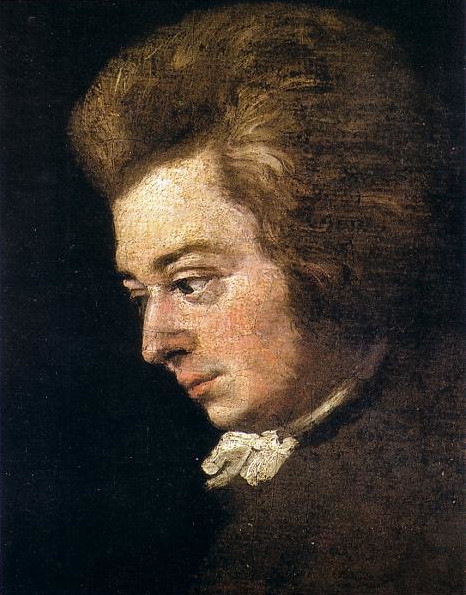 Detail of portrait of Mozart by his brother-in-law Joseph Lange Mozart's physical appearance was described by tenor Michael Kelly in his Reminiscences: "a remarkably small man, very thin and pale, with a profusion of fine, fair hair of which he was rather vain". His early biographer Niemetschek wrote, "there was nothing special about [his] physique. ... He was small and his countenance, except for his large intense eyes, gave no signs of his genius." His facial complexion was pitted, a reminder of his childhood case of smallpox.[98] Of his voice, his wife later wrote that it "was a tenor, rather soft in speaking and delicate in singing, but when anything excited him, or it became necessary to exert it, it was both powerful and energetic."[99] He loved elegant clothing. Kelly remembered him at a rehearsal: "[He] was on the stage with his crimson pelisse and gold-laced cocked hat, giving the time of the music to the orchestra." Based on paintings that researchers were able to find of Mozart, he seemed to wear a white wig for most of his formal occasions—researchers of the Salzburg Mozarteum declared that only one of his fourteen portraits they had found showed him without his wig.[98] Mozart usually worked long and hard, finishing compositions at a tremendous pace as deadlines approached. He often made sketches and drafts; unlike Beethoven's, these are mostly not preserved, as his wife sought to destroy them after his death.[100] Mozart lived at the center of the Viennese musical world, and knew a significant number and variety of people: fellow musicians, theatrical performers, fellow Salzburgers, and aristocrats, including some acquaintance with Emperor Joseph II. Solomon considers his three closest friends to have been Gottfried von Jacquin, Count August Hatzfeld, and Sigmund Barisani; others included his elder colleague Joseph Haydn, singers Franz Xaver Gerl and Benedikt Schack, and the horn player Joseph Leutgeb. Leutgeb and Mozart carried on a kind of friendly mockery, often with Leutgeb as the butt of Mozart's practical jokes.[101] He enjoyed billiards, dancing, and kept pets, including a canary, a starling, a dog, and a horse for recreational riding.[102] He had a startling fondness for scatological humour, which is preserved in his surviving letters, notably those written to his cousin Maria Anna Thekla Mozart around 1777–1778, and in his correspondence with his sister and parents.[103] Mozart also wrote scatological music, a series of canons that he sang with his friends.[104] He had an ear for languages, and having traveled all over Europe as a boy, was fluent in Latin, Italian, and French in addition to his native Salzburg dialect of German. He possibly also understood and spoke some English, having jokingly written "You are an ass" after his 19-year-old student Thomas Attwood made a thoughtless mistake on his exercise papers.[105][106] Mozart was raised a Catholic and remained a devout member of the Church throughout his life.[107][108] He embraced the teachings of Freemasonry in 1784.[109] |
外見と性格 義弟ヨーゼフ・ランゲによるモーツァルトの肖像画の詳細 テノール歌手のマイケル・ケリーは、回想録の中でモーツァルトの容姿をこう語っている: 「驚くほど小柄で、非常に痩せて青白く、色白の細い髪がふさふさと生えており、その髪はかなりうぬぼれが強かった」。彼の初期の伝記作者であるニエメチェ クは、「(彼の)体格には特別なものはなかった。... 彼は小柄で、その表情は大きな強烈な目を除いては、彼の天才的な才能を感じさせるものはなかった」。彼の声について、彼の妻は後に「テノールで、話すとき はやや柔らかく、歌うときは繊細であったが、何かが彼を興奮させたり、それを発揮する必要が生じたりすると、力強くエネルギッシュであった」と書いている [99]。 彼はエレガントな服装を好んだ。ケリーはリハーサルでの彼を次のように記憶している:"彼は真紅のペリセと金レースのコック帽を被って舞台に立ち、オーケ ストラに音楽の時間を与えていた"。ザルツブルグ・モーツァルテウムの研究者は、発見された14枚の肖像画のうち、カツラをかぶっていないのは1枚だけだ と断言している[98]。 モーツァルトは通常、長く懸命に働き、締め切りが近づくにつれ、ものすごいスピードで作曲を仕上げていった。ベートーヴェンのものとは異なり、これらは彼の死後、妻が破棄しようとしたため、ほとんどが保存されていない[100]。 モーツァルトはウィーンの音楽界の中心で生活し、音楽仲間、劇団員、ザルツブルク市民、貴族など、数多くのさまざまな人々と知り合い、皇帝ヨーゼフ2世と も面識があった。ソロモンが最も親しかった3人の友人は、ゴットフリート・フォン・ジャカン、アウグスト・ハッツフェルト伯爵、ジークムント・バリサーニ で、その他に年上の同僚ヨーゼフ・ハイドン、歌手のフランツ・ザヴァー・ゲルル、ベネディクト・シャック、ホルン奏者のヨーゼフ・ロイトゲブがいた。ロイ トゲブとモーツァルトは一種の友好的な嘲笑を交わしており、しばしばロイトゲブがモーツァルトの悪ふざけのネタになっていた[101]。 彼はビリヤードやダンスを楽しみ、カナリア、ムクドリ、犬、乗馬用の馬などのペットを飼っていた[102]。彼は驚くほどスカトロなユーモアが好きで、現 存する手紙、特に1777年から1778年頃に従姉妹のマリア・アンナ・テクラ・モーツァルトに宛てて書かれた手紙や、妹や両親との手紙の中に残されてい る[103]。 [103]モーツァルトはまた、友人たちと歌った一連のカノン曲であるスカトロミュージックも作曲している[104]。彼は語学に長けており、少年時代に ヨーロッパ中を旅したため、母国語であるザルツブルクの方言のドイツ語に加えて、ラテン語、イタリア語、フランス語にも堪能であった。また、19歳の弟子 トーマス・アットウッドが練習問題に軽率なミスをした後、冗談で「You are an ass」と書いたことから、英語も多少理解し、話していた可能性がある[105][106]。 モーツァルトはカトリック教徒として育ち、生涯を通じて敬虔な教会の信者であり続けた[107][108]。1784年にはフリーメイソンの教えを受け入れた[109]。 |
| Works, musical style, and innovations See also: List of compositions by Wolfgang Amadeus Mozart, List of operas by Wolfgang Amadeus Mozart, and Mozart's compositional method Style Symphonie Nr. 40 G minor, K. 550. Movement: 1. Molto allegro Duration: 8 minutes and 14 seconds.8:14 Overture to Don Giovanni Duration: 6 minutes and 49 seconds.6:49 Both performed by the Fulda Symphonic Orchestra, conductor: Simon Schindler Mozart's music, like Haydn's, stands as an archetype of the Classical style. At the time he began composing, European music was dominated by the style galant, a reaction against the highly evolved intricacy of the Baroque. Progressively, and in large part at the hands of Mozart himself, the contrapuntal complexities of the late Baroque emerged once more, moderated and disciplined by new forms, and adapted to a new aesthetic and social milieu. Mozart was a versatile composer, and wrote in every major genre, including symphony, opera, the solo concerto, chamber music including string quartet and string quintet, and the piano sonata. These forms were not new, but Mozart advanced their technical sophistication and emotional reach. He almost single-handedly developed and popularized the Classical piano concerto. He wrote a great deal of religious music, including large-scale masses, as well as dances, divertimenti, serenades, and other forms of light entertainment.[110] The central traits of the Classical style are all present in Mozart's music. Clarity, balance, and transparency are the hallmarks of his work, but simplistic notions of its delicacy mask the exceptional power of his finest masterpieces, such as the Piano Concerto No. 24 in C minor, K. 491; the Symphony No. 40 in G minor, K. 550; and the opera Don Giovanni. Charles Rosen makes the point forcefully: It is only through recognizing the violence and sensuality at the center of Mozart's work that we can make a start towards a comprehension of his structures and an insight into his magnificence. In a paradoxical way, Schumann's superficial characterization of the G minor Symphony can help us to see Mozart's daemon more steadily. In all of Mozart's supreme expressions of suffering and terror, there is something shockingly voluptuous.[111] During his last decade, Mozart frequently exploited chromatic harmony. A notable instance is his String Quartet in C major, K. 465 (1785), whose introduction abounds in chromatic suspensions, giving rise to the work's nickname, the "Dissonance" quartet. Mozart had a gift for absorbing and adapting the valuable features of others' music. His travels helped in the forging of a unique compositional language.[112] In London as a child, he met J. C. Bach and heard his music. In Paris, Mannheim, and Vienna he met with other compositional influences, as well as the avant-garde capabilities of the Mannheim orchestra. In Italy, he encountered the Italian overture and opera buffa, both of which deeply affected the evolution of his practice. In London and Italy, the galant style was in the ascendent: simple, light music with a mania for cadencing; an emphasis on tonic, dominant, and subdominant to the exclusion of other harmonies; symmetrical phrases; and clearly articulated partitions in the overall form of movements.[113] Some of Mozart's early symphonies are Italian overtures, with three movements running into each other; many are homotonal (all three movements having the same key signature, with the slow middle movement being in the relative minor). Others mimic the works of J. C. Bach, and others show the simple rounded binary forms turned out by Viennese composers. 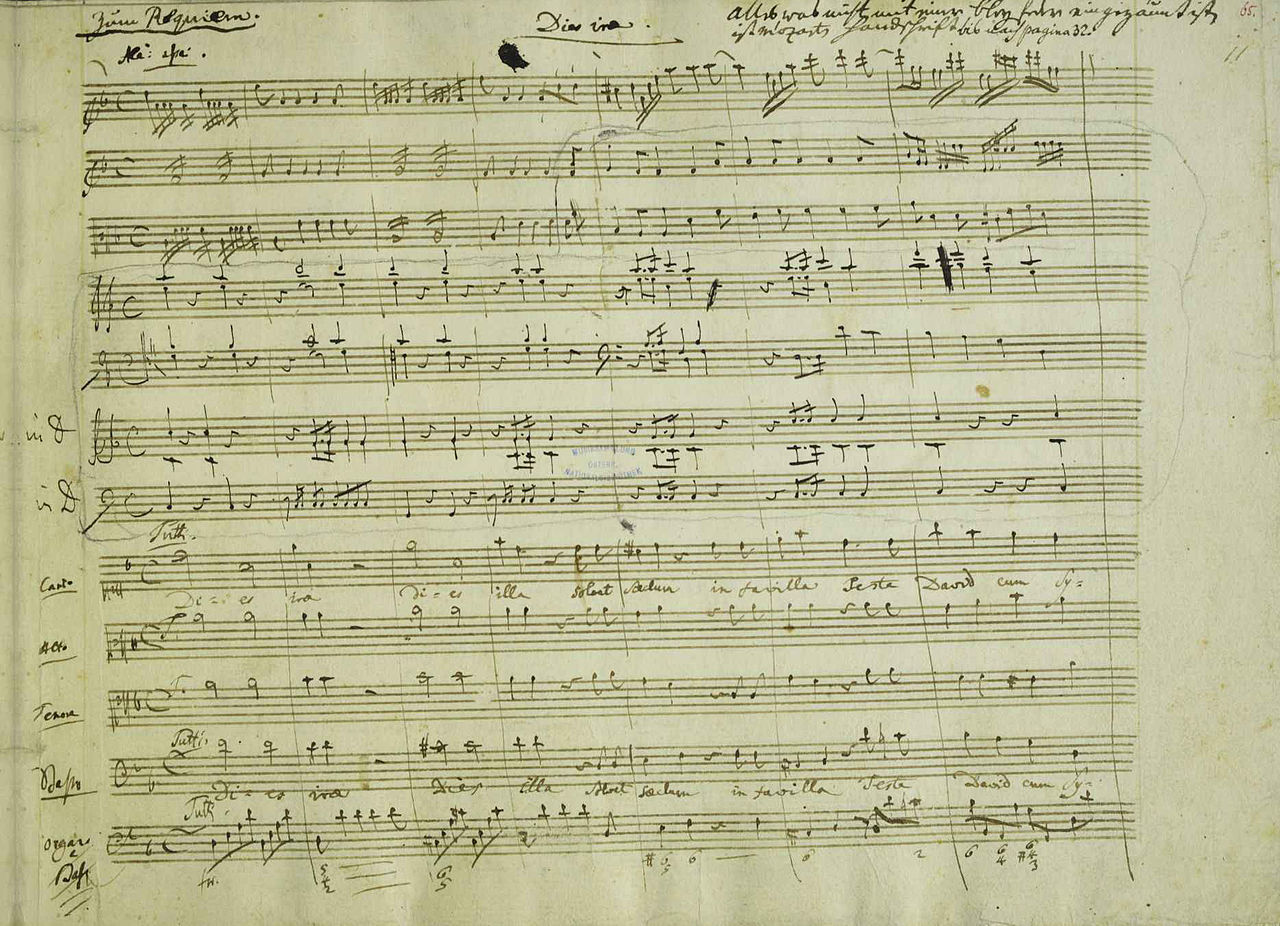 Facsimile sheet of music from the Dies Irae movement of the Requiem Mass in D minor (K. 626) in Mozart's handwriting (Mozarthaus, Vienna) As Mozart matured, he progressively incorporated more features adapted from the Baroque. For example, the Symphony No. 29 in A major K. 201 has a contrapuntal main theme in its first movement, and experimentation with irregular phrase lengths. Some of his quartets from 1773 have fugal finales, probably influenced by Haydn, who had included three such finales in his recently published Opus 20 set. The influence of the Sturm und Drang ("Storm and Stress") period in music, with its brief foreshadowing of the Romantic era, is evident in the music of both composers at that time. Mozart's Symphony No. 25 in G minor K. 183 is another excellent example. Mozart would sometimes switch his focus between operas and instrumental music. He produced operas in each of the prevailing styles: opera buffa, such as Le nozze di Figaro, Don Giovanni, and Così fan tutte; opera seria, such as Idomeneo; and Singspiel, of which Die Zauberflöte is the most famous example by any composer. In his later operas, he employed subtle changes in instrumentation, orchestral texture, and tone colour, for emotional depth and to mark dramatic shifts. Here his advances in opera and instrumental composing interacted: his increasingly sophisticated use of the orchestra in the symphonies and concertos influenced his operatic orchestration, and his developing subtlety in using the orchestra to psychological effect in his operas was in turn reflected in his later non-operatic compositions.[114] Köchel catalogue Main article: Köchel catalogue For unambiguous identification of works by Mozart, a Köchel catalogue number is used. This is a unique number assigned, in regular chronological order, to every one of his known works. A work is referenced by the abbreviation "K." or "KV" followed by this number. The first edition of the catalogue was completed in 1862 by Ludwig von Köchel. It has since been repeatedly updated, as scholarly research improves knowledge of the dates and authenticity of individual works.[115] Instruments Although some of Mozart's early pieces were written for harpsichord, he also became acquainted in his early years with fortepianos made by Regensburg builder Franz Jakob Späth. Later when Mozart was visiting Augsburg, he was impressed by Stein fortepianos and shared this in a letter to his father.[116] On 22 October 1777, Mozart had premiered his triple-piano concerto, K. 242, on instruments provided by Stein. The Augsburg Cathedral organist Demmler was playing the first, Mozart the second and Stein the third part.[117] In 1783 when living in Vienna he purchased an instrument by Walter.[118] Leopold Mozart confirmed the attachment which Mozart had with his Walter fortepiano: "It is impossible to describe the hustle and bustle. Your brother's pianoforte has been moved at least twelve times from his house to the theatre or to someone else's house."[119] |
作品、音楽スタイル、革新性 こちらも参照のこと: ヴォルフガング・アマデウス・モーツァルトの作曲リスト、ヴォルフガング・アマデウス・モーツァルトのオペラリスト、モーツァルトの作曲法も参照のこと。 様式 交響曲第40番 ト短調 K. 550. 楽章 1. モルト・アレグロ 演奏時間:8分14秒8:14 歌劇「ドン・ジョヴァンニ」序曲 演奏時間: 6分49秒 6:49 指揮:フルダ交響楽団 指揮:シモン・シンドラー モーツァルトの音楽は、ハイドンの音楽と同様、古典派様式の典型である。彼が作曲を始めた当時のヨーロッパ音楽は、バロックの高度に進化した複雑性への反 動として、ガラン様式が主流だった。その後、モーツァルト自身の手によって、後期バロックの複雑な対位法が再び出現し、新しい形式によって緩和され、規律 づけられ、新しい美的・社会的環境に適合するようになった。モーツァルトは多才な作曲家で、交響曲、オペラ、独奏協奏曲、弦楽四重奏曲や弦楽五重奏曲など の室内楽、ピアノ・ソナタなど、あらゆる主要なジャンルを作曲した。これらの形式は決して新しいものではなかったが、モーツァルトはその技術的な洗練と感 情的な広がりを発展させた。彼はほとんど独力で古典派のピアノ協奏曲を発展させ、普及させた。大規模なミサ曲を含む多くの宗教音楽、舞曲、ディヴェルティ メンティ、セレナーデ、その他の軽快な娯楽曲も作曲した[110]。 モーツァルトの音楽には、古典派様式の中心的な特徴がすべて存在している。明瞭さ、バランス、透明性は彼の作品の特徴であるが、その繊細さを単純化する と、ピアノ協奏曲第24番ハ短調K.491、交響曲第40番ト短調K.550、オペラ「ドン・ジョヴァンニ」のような彼の最高傑作の並外れた力が覆い隠さ れてしまう。 チャールズ・ローゼンは力説する: モーツァルトの作品の中心にある暴力性と官能性を認識することによってのみ、私たちは彼の構造を理解し、その素晴らしさを洞察するためのスタートを切るこ とができる。逆説的な言い方をすれば、シューマンが ト短調交響曲を表面的に特徴づけることで、モーツァルトのデーモンをより着実に見ることができるのである。モーツァルトの苦しみと恐怖の至高の表現には、 衝撃的なまでに官能的なものがある[111]。 晩年の10年間、モーツァルトは半音階的和声を頻繁に用いた。その顕著な例が、彼の弦楽四重奏曲ハ長調K.465(1785年)であり、その序奏は半音階的な中断にあふれ、この作品が「不協和音」四重奏曲というニックネームを生んだ。 モーツァルトには、他人の音楽の貴重な特徴を吸収し、適応させる才能があった。幼少の頃、ロンドンでJ.C.バッハに出会い、彼の音楽を聴いた。パリ、マ ンハイム、ウィーンでは、他の作曲家の影響や、マンハイム・オーケストラの前衛的な能力に出会った。イタリアでは、イタリア風序曲と オペラ・ブッファに出会い、その両方が彼の練習の進化に深い影響を与えた。ロンドンとイタリアではガラント・スタイルが台頭していた。シンプルで軽快な音 楽にカデンシングのマニアックさ、トニック、ドミナント、サブドミナントを強調し、他のハーモニーを排除すること、対称的なフレーズ、楽章の全体的な形式 における明確な分割などである[113]。モーツァルトの初期の交響曲のいくつかは、3つの楽章が互いに連続するイタリア序曲であり、多くはホモトナル (3つの楽章すべてが同じ調号を持ち、緩徐楽章は相対短調)である。また、J.C.バッハの作品を模倣したものや、ウィーンの作曲家が生み出した単純な丸 みを帯びた二進法の形式を示すものもある。  モーツァルトの自筆譜によるレクイエム・ミサ曲ニ短調(K.626)のディエス・イレ楽章のファクシミリ楽譜(ウィーン、モーツァルトハウス蔵) モーツァルトは成熟するにつれて、バロックから取り入れた特徴を徐々に取り入れていった。例えば、交響曲第29番イ長調K.201では、第1楽章にコント ラプンタルの主旋律があり、不規則なフレーズの長さが試みられている。1773年からの四重奏曲にはフーガ的な終楽章があるが、これはハイドンの影響であ ろう。ロマン派の時代を短期間予感させる音楽のシュトルム・ウント・ドラング(「嵐とストレス」)の時代の影響は、この時期の両作曲家の音楽に顕著であ る。モーツァルトの交響曲第25番ト短調K.183もその好例だ。 モーツァルトは、オペラと器楽曲の間を行き来することもあった。フィガロの結婚』、『ドン・ジョヴァンニ』、『コジ・ファン・トゥッテ』などのオペラ・ ブッファ、『イドメネオ』などのオペラ・セリア、『魔笛』などの歌劇などである。後期のオペラでは、感情的な深みと劇的な変化を表現するために、楽器編 成、管弦楽のテクスチュア、音色を微妙に変化させた。交響曲と協奏曲における彼のオーケストラの洗練された使い方は、オペラのオーケストレーションに影響 を与え、オペラにおける心理的効果をもたらすオーケストラの繊細な使い方は、その後のオペラ以外の作品にも反映された[114]。 ケッヘルのカタログ 主な記事 ケッヘル目録 モーツァルトの作品を明確に識別するために、ケッヘル目録番号が用いられている。ケッヘル番号とは、モーツァルトが作曲したすべての作品に、年代順に付け られた一意の番号である。作品は、"K. "または "KV "という略号の後にこの番号を付けて参照される。カタログの初版は、ルートヴィヒ・フォン・ケッヘルによって1862年に完成された。その後、学術的な研 究によって個々の作品の年代や真正性に関する知識が向上するにつれて、繰り返し更新されている[115]。 楽器 モーツァルトの初期の作品はチェンバロのために書かれたものもあるが、レーゲンスブルクの製作者フランツ・ヤコブ・シュペースが製作したフォルテピアノに も若い頃に親しんだ。その後、アウクスブルクを訪れたモーツァルトは、シュタインのフォルテピアノに感銘を受け、父に宛てた手紙の中でそのことを語ってい る[116]。 1777年10月22日、モーツァルトは、シュタインが提供した楽器で3台ピアノ協奏曲K.242を初演した。アウグスブルク大聖堂のオルガニスト、デム ラーが第1パートを、モーツァルトが第2パートを、そしてシュタインが第3パートを演奏していた[117]。 1783年、ウィーンに住んでいたモーツァルトは、ワルターの楽器を購入した[118]。 レオポルト・モーツァルトは、モーツァルトがワルターのフォルテピアノに愛着を持っていたことを確認した。あなたの弟のピアノフォルテは、少なくとも12 回は彼の家から劇場や他の人の家に移された」[119]。 |
| Influence See also: Wolfgang Amadeus Mozart in popular culture 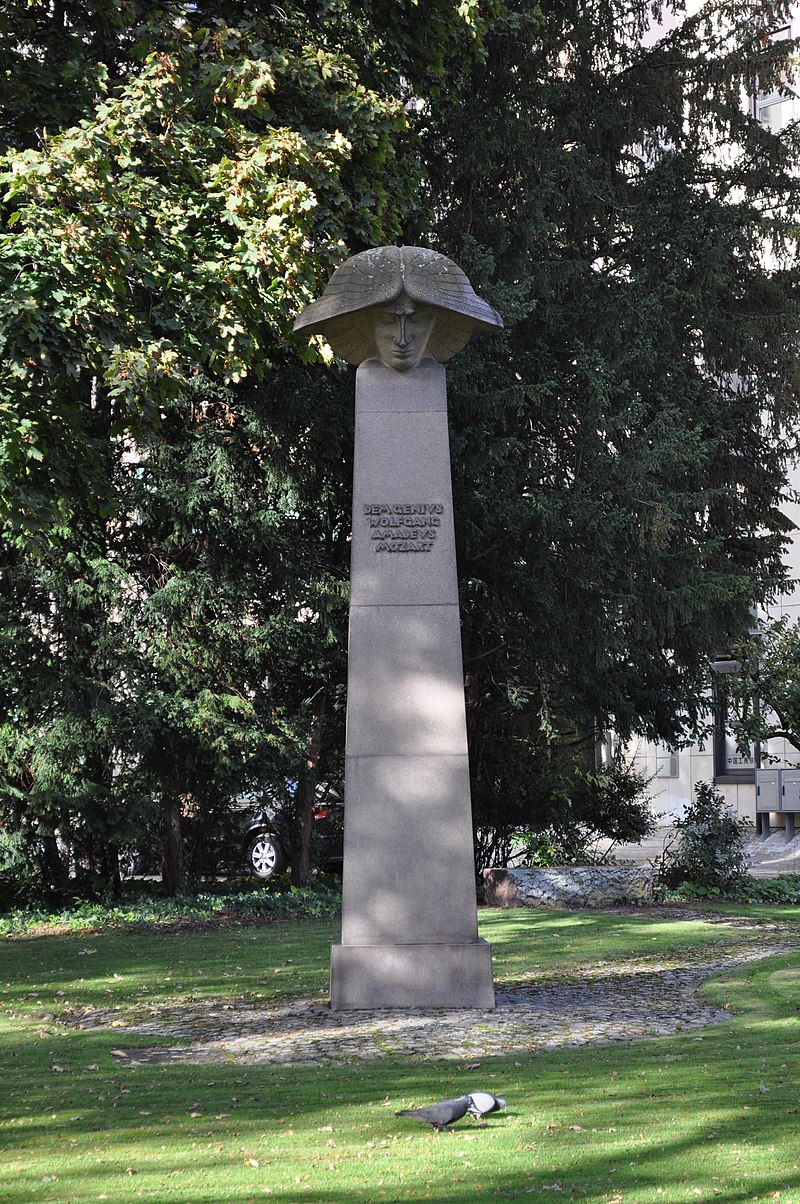 Mozart Monument [de], Mozartplatz, Frankfurt His most famous pupil was Johann Nepomuk Hummel,[120] a transitional figure between the Classical and Romantic eras whom the Mozarts took into their Vienna home for two years as a child.[121] More important is the influence Mozart had on composers of later generations. Ever since the surge in his reputation after his death, studying his scores has been a standard part of classical musicians' training.[122] Ludwig van Beethoven, Mozart's junior by fifteen years, was deeply influenced by his work, with which he was acquainted as a teenager.[123] He is thought to have performed Mozart's operas while playing in the court orchestra at Bonn[124] and travelled to Vienna in 1787 hoping to study with the older composer. Some of Beethoven's works have direct models in comparable works by Mozart, and he wrote cadenzas (WoO 58) to Mozart's D minor piano concerto K. 466.[125][i] Composers have paid homage to Mozart by writing sets of variations on his themes. Beethoven wrote four such sets (Op. 66, WoO 28, WoO 40, WoO 46).[126] Others include Fernando Sor's Introduction and Variations on a Theme by Mozart (1821), Mikhail Glinka's Variations on a Theme from Mozart's Opera The Magic Flute (1822), Frédéric Chopin's Variations on "Là ci darem la mano" from Don Giovanni (1827), and Max Reger's Variations and Fugue on a Theme by Mozart (1914), based on the variation theme in the piano sonata K. 331.[127] Pyotr Ilyich Tchaikovsky, who revered Mozart, wrote his Orchestral Suite No. 4 in G, Mozartiana (1887), as a tribute to him.[128] |
影響 こちらも参照のこと: 大衆文化におけるヴォルフガング・アマデウス・モーツァルト  モーツァルト記念碑[デ]、モーツァルト広場、フランクフルト 彼の最も有名な弟子はヨハン・ネポムク・フンメルであり[120]、古典派とロマン派の過渡期の人物である。彼の死後、その名声が急上昇して以来、彼の楽譜を研究することはクラシック音楽家の訓練の定番となっている[122]。 ルートヴィヒ・ヴァン・ベートーヴェンは、モーツァルトの15歳年下であり、10代の頃に親しんだモーツァルトの作品から深い影響を受けている [123]。 彼は、ボンの宮廷楽団で演奏しながらモーツァルトのオペラを演奏したと考えられており[124]、年上の作曲家に師事することを望んで1787年にウィー ンに渡った。ベートーヴェンの作品のいくつかは、モーツァルトの同種の作品に直接のモデルがあり、彼はモーツァルトのニ短調ピアノ協奏曲K.466の カデンツァ(WoO58)を書いている[125][i]。 作曲家たちは、モーツァルトの主題による変奏曲のセットを書くことで、モーツァルトへのオマージュを捧げてきた。ベートーヴェンはそのようなセットを4曲 書いている(作品66、WoO 28、WoO 40、WoO 46)。 [その他にも、フェルナンド・ソールの「モーツァルトの主題による序奏と変奏」(1821年)、ミハイル・グリンカの「モーツァルトのオペラ『魔笛』の主 題による変奏曲」(1822年)、フレデリック・ショパンの「ドン・ジョヴァンニ」の「Là ci darem la mano」による変奏曲(1827年)、マックス・レーガーの「モーツァルトの主題による変奏曲とフーガ」(1914年)などがある。モーツァルトを敬愛 するピョートル・イリイチ・チャイコフスキーは、モーツァルトへのオマージュとして管弦楽組曲第4番ト長調「モーツァルティアーナ」(1887年)を作曲 した[128]。 |
| https://en.wikipedia.org/wiki/Wolfgang_Amadeus_Mozart |
|
リ ンク
文 献
そ の他の情報
Copyleft, CC, Mitzub'ixi Quq Chi'j, 1996-2099
☆
 ☆
☆